Prepare Smarter for CCNA 200-301 Exam with Our Free and Accurate CCNA 200-301 Exam Questions – 2025 Updated.
At Cert Empire we are committed to providing the best and the latest exam questions to the aspiring students who are preparing for CISCO CCNA 200-301 Exam. To help the students prepare better, we have made sections of our CCNA 200-301 exam preparation resources free for all. You can practice as much as you can with Free CCNA 200-301 Practice Test.
Question 1
Show Answer
A: It causes a network loop when a violation occurs. Port security violation actions
(shutdown, restrict, protect) are designed to secure the port, not cause network loops.
B: It disables the native VLAN configuration as soon as port security is enabled. Enabling
port security does not inherently alter or disable the native VLAN configuration; these are
separate features.
D: It places the port in the err-disabled slate after 10 MAC addresses are statically
configured. The default maximum MAC addresses is 1, not 10. The violation occurs upon
learning MACs beyond the limit, not specifically after static configuration of a certain
number.
Cisco Systems, "Configuring Port Security," Catalyst 9300 Series Switches, Cisco IOS XE
Bengaluru 17.6.x, Security Configuration Guide.
/561
Relevant Sections: "Port Security Default Configuration" (states maximum MAC addresses
is 1, violation mode is Shutdown) and "Enabling Port Security on an Interface" (confirms
defaults apply to trunk ports).
Cisco Systems, "Catalyst 3750-X and 3560-X Switch Software Configuration Guide,
Release 15.0(2)SE and Later," Chapter: "Configuring Port Security."
URL:
https://www.cisco.com/c/en/us/td/docs/switches/lan/catalyst3750x3560x/software/release/15
-02se/configuration/guide/scg3750x/swps.html
Relevant Section: "Port Security Default Settings" (Table 21-1 lists "Maximum number of
secure MAC addresses" as 1 and "Violation mode" as "shutdown"). "Port Security on Trunk
Ports" (explains port security applies to all VLANs on the trunk).
/561
Question 2
Show Answer
A: broadcast to all ports on the switch
C: forwarded to the first available port
D: inspected and dropped by the switch
Odom, W. (2019). CCNA 200-301 Official Cert Guide, Volume 1. Cisco Press. Chapter 2,
"Fundamentals of Ethernet LANs," Section: "Sending Data in Ethernet Networks,"
Subsection: "Switch Forwarding: The General Idea" (specifically discusses unknown unicast
frames and flooding).
"When a switch receives a frame whose destination MAC address is unicast, but that MAC
address is not in the MAC address table, the switch floods the frame. Flooding means that
the switch forwards a copy of the frame out all ports except the port on which the frame
arrived."
Cisco Networking Academy. (n.d.). CCNAv7: Switching, Routing, and Wireless Essentials.
Module 2: Switching Concepts, Section 2.2.2: The MAC Address Table.
/561
"If the destination MAC address is not in the table, the switch will forward the frame out all
ports except the incoming port. This is called an unknown unicast." (Accessible via Cisco
NetAcad learning platform).
Tanenbaum,
A. S., & Wetherall,
D. J. (2011). Computer Networks (5th ed.). Pearson
Education. Chapter 4, "The Medium Access Control Sublayer," Section 4.3.2 "Bridges and
Switches."
While a general networking textbook, it describes the fundamental operation: "If the
destination port is unknown, the frame is broadcast on all ports except the one it arrived on
(flooding)." (This aligns with the Cisco-specific behavior for unknown unicast frames).
/561
Question 3
 An engineer is configuring a Layer 3 port-channel interface with LACP. The configuration on
the first device is complete, and it is verified that both interfaces have registered the
neighbor device in the CDP table. Which task on the neighbor device enables the new port
channel to come up without negotiating the channel?
A: Change the EtherChannel mode on the neighboring interfaces to auto.
B: Configure the IP address of the neighboring device.
C: Bring up the neighboring interfaces using the no shutdown command.
D: Modify the static EtherChannel configuration of the device to passive mode.
An engineer is configuring a Layer 3 port-channel interface with LACP. The configuration on
the first device is complete, and it is verified that both interfaces have registered the
neighbor device in the CDP table. Which task on the neighbor device enables the new port
channel to come up without negotiating the channel?
A: Change the EtherChannel mode on the neighboring interfaces to auto.
B: Configure the IP address of the neighboring device.
C: Bring up the neighboring interfaces using the no shutdown command.
D: Modify the static EtherChannel configuration of the device to passive mode.Show Answer
A. auto is a PAgP (proprietary) mode, not valid for LACP; channel will not form.
B. An IP address is configured on the logical Port-Channel, not on individual member ports;
it does not influence LACP state.
C. Interfaces are already up (CDP sees the neighbor); issuing no shutdown adds nothing.
/561
1. Cisco Systems, Configuring EtherChannels, Catalyst 9000 Series Switches IOS XE 17,
section LACP Modesactive and passive. https://www.cisco.com/c/en/us/td/docs/iosxml/ios/lanswitch/configuration/xe-17/lanswitch-xe-17-book/lnsw-etherchannel.html
2. IEEE Std 802.1AX-2020, clause 5.3.1: passive participants only respond to LACPDUs,
allowing aggregation when the peer is active.
/561
Question 4
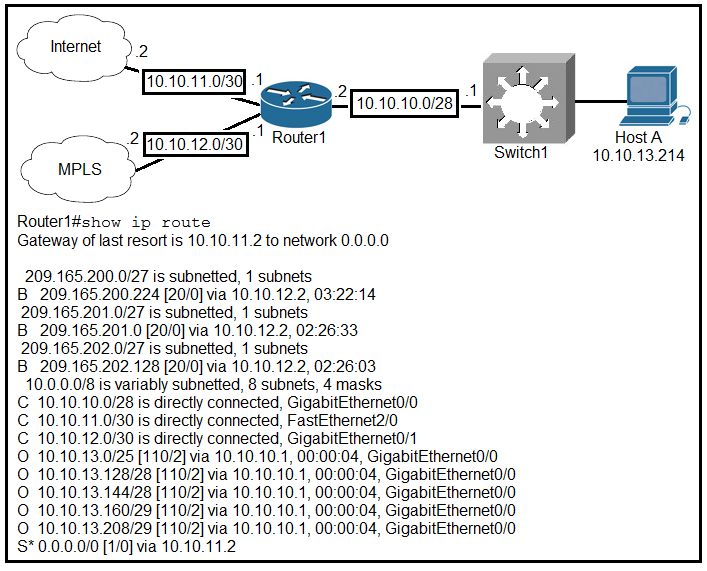 What is the subnet mask of the route to the 10.10.13.160 prefix?
A: 255.255.255.240
B: 255.255.255.128
C: 255.255.248.
D: 255.255.255.248
What is the subnet mask of the route to the 10.10.13.160 prefix?
A: 255.255.255.240
B: 255.255.255.128
C: 255.255.248.
D: 255.255.255.248Show Answer
A: 255.255.255.240 This mask corresponds to a /28 prefix length (28 bits set to 1), not /29.
B: 255.255.255.128 This mask corresponds to a /25 prefix length (25 bits set to 1), not /29.
C: 255.255.248. This option is an improperly formatted mask. If interpreted as
255.255.248.0, it corresponds to a /21 prefix length, not /29.
1. Odom, W. (2019). CCNA 200-301 Official Cert Guide, Volume 1. Cisco Press. Chapter
13, "Implementing IP Addressing and Subnetting," Table 13-6 "Common IPv4 Prefix Lengths
and Their Equivalent Dotted-Decimal Masks" (lists /29 as 255.255.255.248). Chapter 20,
"Learning IPv4 Routes with OSPFv2," discusses interpreting show ip route output, including
prefix lengths.
2. Kurose,
J. F., & Ross,
K. W. (2021). Computer Networking: A Top-Down Approach (8th
ed.). Pearson. Chapter 4, Section 4.3.2 "IP Addressing: CIDR" (explains the /x prefix
notation).
3. Cisco IOS IP Routing: Protocol-Independent Configuration Guide, Cisco IOS XE Release
3S. (n.d.). Displaying the IP Routing Table. Cisco. Retrieved from
(Illustrates show ip route command usage and output format, including prefix length
notation).
/561
Question 5
Show Answer
A: to secure physical access to a data center: Cisco DNA Center is a network management
platform, not a system for controlling physical access to facilities.
B: to scan a network and generate a Layer 2 network diagram: While DNA Center can
discover devices and display network topology, this is a feature supporting its broader
management purpose, not the primary purpose itself.
D: to provide Layer 3 services to autonomous access points: DNA Center manages network
infrastructure, including wireless controllers or fabric-enabled APs, rather than directly
providing Layer 3 routing services to autonomous APs.
Cisco. (n.d.). Cisco DNA Center At-A-Glance. Cisco. Retrieved from
https://www.cisco.com/c/dam/en/us/products/collateral/cloud-systems-management/dnacenter/nb-06-dna-center-aag-ctp-en.pdf (Page 1: "Cisco DNA Center is the network
management and command center for Cisco DNA... Automate device deployment...
Manage your network... Secure your network.")
Cisco. (n.d.). Cisco DNA Center Data Sheet. Cisco. Retrieved from
https://www.cisco.com/c/en/us/products/collateral/cloud-systems-management/dnacenter/datasheet-c78-739944.html (Section: "Product overview" - "Cisco DNA Center
provides a centralized management dashboard... for automation... and assurance.")
/561
Odom, W. (2020). CCNA 200-301 Official Cert Guide, Volume 2. Cisco Press. (Chapter 23:
Introduction to Controller-Based Networking - "Cisco DNA Center provides a centralized
GUI to design, provision, apply policy, and provide assurance for the enterprise network.")
/561
Question 6
Show Answer
A. PSK Pre-Shared Key was the WPA/WPA2 authentication method; WPA3 replaces it with
SAE and still uses AES for encryption.
B. TKIP Deprecated after WPA; explicitly disallowed in WPA3 because it lacks modern
cryptographic strength.
C. SAE A password-authenticated key-exchange protocol, not an encryption algorithm; it
produces the keys that feed AES-based ciphers.
1. Wi-Fi Alliance, Wi-Fi CERTIFIED WPA3™ Security Technical Overview, §3.2: WPA3
networks use AES-CCMP-128 (or AES-GCMP-256 in WPA3-Enterprise-192) for data
encryption. https://www.wi-fi.org/file/wpa3-specification
2. IEEE Std 802.11-2020, Clause 12.4 & 12.6: CCMP/GCMP (AES) defined as required
suites; TKIP prohibited.
3. IEEE Std 802.11-2020, Annex J: Simultaneous Authentication of Equals (SAE) ¦ provides
authentication; encryption is achieved with AES-based CCMP or GCMP.
/561
Question 7
Show Answer
A: per-device: This describes traditional management, where administrators often configure
each device individually, which Cisco DNA Center aims to overcome.
C: device-by-device hands-on: This is characteristic of traditional network management, not
the automated, centralized approach of Cisco DNA Center.
D: CLI-oriented device: While CLI access is still possible, Cisco DNA Center emphasizes
GUI-based management and automation, moving away from primarily CLI-oriented
traditional methods.
Cisco. (n.d.). Cisco DNA Center At-a-Glance. Cisco. Retrieved from
https://www.cisco.com/c/en/us/products/collateral/cloud-systems-management/dnacenter/nb-06-dna-center-aag-ctp-en.html (Page 1: "Cisco DNA Center is the network
management and command center for your Cisco DNA network. This centralized, intuitive
management hub...")
Cisco. (n.d.). Cisco DNA Center Solution Overview. Cisco. Retrieved from
https://www.cisco.com/c/en/us/products/collateral/cloud-systems-management/dna/561
center/solution-overview-c22-738477.html (Page 2: "Traditional networks are hardware-
centric, manually configured, fragmented in their management...")
Odom, W. (2020). CCNA 200-301 Official Cert Guide, Volume 2. Cisco Press. (Chapter 23:
"Introduction to Controller-Based Networking" - discusses the shift from traditional per-
device management to centralized controller-based models like Cisco DNA Center).
/561
Question 8
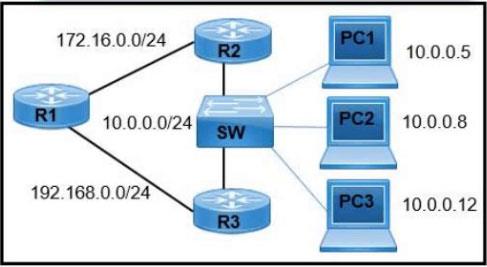 A network engineer must configure R1 so that it sends all packets destined to the
10.0.0.0/24 network to R3, and all packets destined to PC1 to R2. Which configuration must
the engineer implement?
A network engineer must configure R1 so that it sends all packets destined to the
10.0.0.0/24 network to R3, and all packets destined to PC1 to R2. Which configuration must
the engineer implement?Show Answer
A. Routes are reversed/24 points to R2 and /32 to R3, contradicting the requirement.
B. Uses 255.255.0.0 (/16), not /24, so it covers many unintended networks.
D. Masks are incorrect (/16 for network, /24 for host), and next-hop directions are reversed.
1. Cisco IOS XE 17 IP Routing: Static Routes Configuration Guide Example: host (/32)
route overriding network route.
2. Doyle,
J. & Carroll,
J. Routing TCP/IP, Volume I, 2nd ed., Cisco Press, 2005. Section 3.2
Static Routes and Longest-Match Routing, pp. 76-78.
/561
Question 9
Show Answer
A: snmp-server host: This command specifies a trap/inform receiver and can be used with
SNMPv1, v2c, or v3, depending on other parameters.
B: snmp-server community: This command configures community strings, which are
primarily used for SNMPv1 and SNMPv2c.
C: snmp-server enable traps: This command globally enables the sending of SNMP traps
and is not specific to any SNMP version.
Cisco IOS SNMP Configuration Guide: "Configuring SNMPv3 Users" section typically
details the snmp-server user command. For example, in the SNMP Configuration Guide,
Cisco IOS Release 15M&T, the snmp-server user command is described as: "To configure a
new user to an SNMP group for SNMPv3."
Direct URL (example for a specific IOS version, concept is general): Cisco.com, search for
"SNMP Configuration Guide" for relevant IOS. A general reference: Cisco Press, "CCNA
200-301 Official Cert Guide, Volume 1," Chapter 25: IP Services, section "Configuring and
Verifying SNMP." (While commercial prep, the underlying Cisco IOS command functionality
is standard).
Official Cisco Documentation (Conceptual): "Simple Network Management Protocol
Configuration Guide, Cisco IOS XE Gibraltar 16.12.x" - Chapter: Configuring SNMPv3. This
/561
guide states: "SNMPv3 provides for both security models and security levels. A security
model is an authentication strategy that is set up for a user and the group in which the user
resides. A security level is the permitted level of security within a security model." The
snmp-server user command is central to this. (Available via Cisco's public documentation
portal).
Cisco IOS Master Command List: Searching for snmp-server user will show its syntax and
purpose, clearly linking it to SNMPv3.
Direct URL (example): Cisco.com, search for "Cisco IOS Master Command List" and then
navigate to the specific command. For instance, snmp-server user command reference.
Academic Source (Conceptual understanding of SNMPv3):
Stallings, W. (2016). Foundations of Modern Networking: SDN, NFV, QoE, IoT, and Cloud.
Pearson Education, Inc. Chapter 5, "Network Management," discusses SNMPv3 and its
User-based Security Model (USM), which relies on configured users. (This provides the
theoretical background for why user configuration is key to SNMPv3).
/561
Question 10
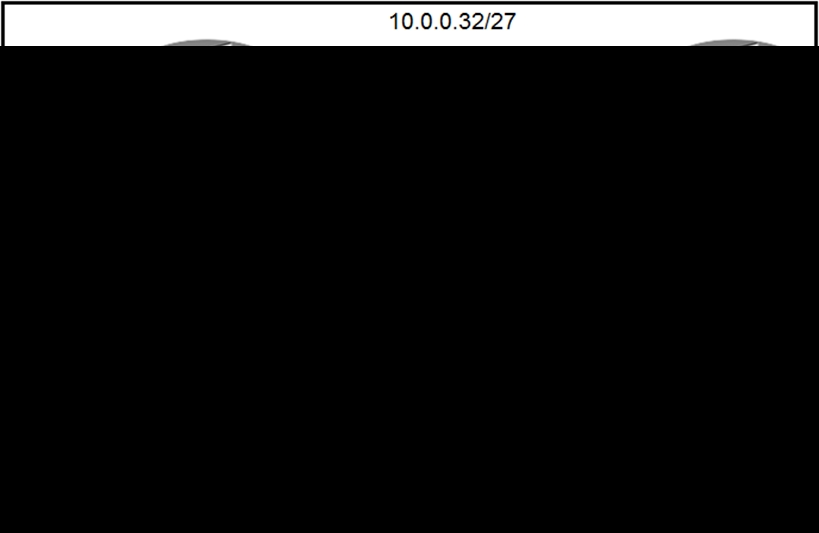 An engineer must configure router R2 so it is elected as the DR on the WAN subnet. Which
command sequence must be configured?
A: interface gigabitethernet0/0 ip address 10.0.0.34 255.255.255.248 ip ospf priority 0
B: interface gigabitethernet0/0 ip address 10.0.0.34 255.255.255.224 ip ospf priority 100
C: interface gigabitethernet0/0 ip address 10.0.1.1 255.255.255.0 ip ospf priority 255
D: interface gigabitethernet0/0 ip address 10.0.1.1 255.255.255.224 ip ospf priority 98
An engineer must configure router R2 so it is elected as the DR on the WAN subnet. Which
command sequence must be configured?
A: interface gigabitethernet0/0 ip address 10.0.0.34 255.255.255.248 ip ospf priority 0
B: interface gigabitethernet0/0 ip address 10.0.0.34 255.255.255.224 ip ospf priority 100
C: interface gigabitethernet0/0 ip address 10.0.1.1 255.255.255.0 ip ospf priority 255
D: interface gigabitethernet0/0 ip address 10.0.1.1 255.255.255.224 ip ospf priority 98Show Answer
A – Priority 0 prevents the router from participating in the DR/BDR election.
C – Places R2 in a different IP subnet (10.0.1.0/24); it would not form adjacency on the
WAN link.
D – Subnet mismatch (10.0.1.0/27) prevents adjacency; also uses lower priority than option
B.
1. Cisco IOS “ip ospf priority” command— Cisco Networking Software Command Reference,
IP Routing OSPF, §“Usage Guidelines”.
https://www.cisco.com/c/en/us/td/docs/ios/iosxe/iproute/command/ir-cr-book/iri1.html#wp1050757
2. RFC 2328, OSPF Version 2, J. Moy, Internet Engineering Task Force, Apr 1998, §9.4
(Router Priority).
https://datatracker.ietf.org/doc/html/rfc2328#section-9.4
/561
Question 11
 What is represented by "R1" and "SW1" within the JSON output?
A: key
B: array
C: value
D: object
What is represented by "R1" and "SW1" within the JSON output?
A: key
B: array
C: value
D: objectShow Answer
A. key Keys are the names on the left side of the colon; R1, SW1 are on the right.
B. array An array is an ordered list enclosed in [ ]; R1, SW1 are individual elements, not the
array container itself.
D. object A JSON object is a collection of name/value pairs delimited by { }; R1, SW1 are
primitive string values inside the object, not the object itself.
1. IETF RFC 8259: The JavaScript Object Notation (JSON) Data Interchange Format, §2
Objects and Values https://www.rfc-editor.org/rfc/rfc8259#section-2
/561
2. ECMA-404: The JSON Data Interchange Standard, §5 Values https://www.ecmainternational.org/wp-content/uploads/ECMA-4042ndeditiondecember2017.pdf
/561
Question 12
Show Answer
A: Single sign-on (SSO) is an authentication scheme for accessing multiple services with
one login; it can be secured by MFA but is not MFA itself.
C: Passwords that expire is a security policy for a single authentication factor (password),
not an additional, distinct factor required for MFA.
E: Shared password responsibility is an administrative policy or practice concerning
password management, not an authentication factor or MFA method.
1. Cisco, "What Is Multifactor Authentication (MFA)?" (No specific page, general article)
Direct URL: https://www.cisco.com/c/en/us/products/security/what-is-multifactorauthentication-mfa.html
This source defines MFA as requiring two or more verification factors and lists "Knowledge
(something only the user knows)" and "Possession (something only the user has)" as
categories, aligning with options B and D.
/561
2. Odom, W. (2019). CCNA 200-301 Official Cert Guide, Volume 1. Cisco Press.
Chapter 27, "Securing Network Devices," Section: "Passwords and Alternative
Authentication Methods."
This guide states: "Multifactor authentication (MFA) requires more than one type of
authentication. The types are often listed as follows: Something you know (for example, a
password) [and] Something you have (for example, a smart card or a token device that
generates a one-time password)." This supports "unique user knowledge" (B) and "soft
tokens" (D) as components of MFA.
3. National Institute of Standards and Technology (NIST). (2017). NIST Special Publication
800-63B: Digital Identity Guidelines: Authentication and Lifecycle Management.
Section 4, "Authentication Factors" (pp. 9-11).
Direct URL: https://nvlpubs.nist.gov/nistpubs/SpecialPublications/NIST.SP.800-63b.pdf
This document defines authentication factors: "Something you know" (Section 4.1,
supporting option B) and "Something you have" (Section 4.2, of which soft tokens are an
example, supporting option D). MFA involves using factors from at least two of these
categories.
/561
Question 13
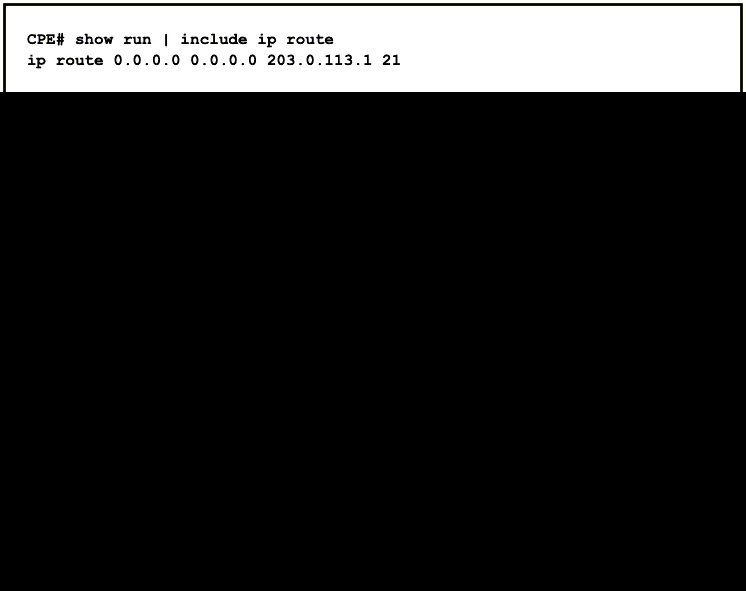 After configuring a new static route on the CPE. the engineer entered this series of
commands to verify that the new configuration is operating normally When is the static
default route installed into the routing table?
A: when 203 0 113.1 is no longer reachable as a next hop
B: when the default route learned over external BGP becomes invalid
C: when a route to 203.0 113 1 is learned via BGP
D: when the default route over external BGP changes its next hop
After configuring a new static route on the CPE. the engineer entered this series of
commands to verify that the new configuration is operating normally When is the static
default route installed into the routing table?
A: when 203 0 113.1 is no longer reachable as a next hop
B: when the default route learned over external BGP becomes invalid
C: when a route to 203.0 113 1 is learned via BGP
D: when the default route over external BGP changes its next hopShow Answer
A: If 203.0.113.1 (the static™ s next-hop) is unreachable, the static route is removed, not
installed.
C: Learning 203.0.113.1 via BGP merely provides recursive reachability; it does not trigger
installation while a lower-AD default still exists.
D: A change of next hop on the active eBGP default does not invalidate it; the route remains
preferred, so the static is still suppressed.
1. Cisco IOS IP Routing Configuration Guide, Administrative Distance explains that a route
with a higher AD becomes active only when lower-AD routes disappear.
https://www.cisco.com/c/en/us/support/docs/ip/enhanced-interior-gateway-routing-protocoleigrp/47834-ad-admin-distance.html (see section Floating Static Routes).
2. Odom, W. CCNA 200-301 Official Cert Guide, Vol 1, ch. 18 Static and Default Routes, pp.
387-389 discussion of floating statics and their installation behavior.
/561
Question 14
Show Answer
A: Integrity checks (like MIC) verify that data has not been altered during transmission,
which is a separate security service from encryption's primary goal of confidentiality.
B: Encryption primarily ensures data confidentiality, not the detection or prevention of zero-
day attacks, which exploit unknown vulnerabilities in software or hardware.
D: Preventing unauthorized users from communicating is primarily the role of authentication
and access control mechanisms (e.g., WPA2-PSK, 802.1X), not encryption itself.
1. Odom, W. (2019). CCNA 200-301 Official Cert Guide, Volume 1. Cisco Press. Chapter
13: Implementing Wireless LANs, Section: "Wireless LAN Security," Sub-section:
"Confidentiality with Encryption Protocols." (Specifically, "Wireless LANs use encryption to
encode the data so that if it is intercepted, the data cannot be interpreted (confidentiality).")
2. Cisco. (2018). Wireless LAN Security Overview. Cisco Design Guide. Retrieved from
https://www.cisco.com/c/en/us/td/docs/solutions/Enterprise/Mobility/emob41dg/emob41dgwrapper/ch2Secu.html (Section: "Confidentiality," "Encryption is the process of scrambling
data so that it cannot be read by anyone other than the intended recipient.")
3. Cisco. (2023). End-to-End Security with WPA2. Cisco Technical Document. Retrieved
from https://www.cisco.com/c/en/us/support/docs/wireless-mobility/wlan-security/200540/561
End-to-End-Security-with-WPA2.html (Defines encryption as: "The process of encoding
information to make it unreadable to unauthorized parties. In Wi-Fi, encryption protects the
confidentiality of data transmitted over the air.")
/561
Question 15
Show Answer
A: Off-site syslog backup is a data-protection/continuity control, not a facility access
restriction.
B: Console-port passwords protect logical device access, not physical entry to
infrastructure.
C: Enable passwords secure privileged EXEC modeagain a logical access control, not a
physical one.
1. NIST Special Publication 800-53 Rev. 5, PE-6 Monitoring Physical Access, pp. 290-291.
https://doi.org/10.6028/NIST.SP.800-53r5
2. Cisco Systems, Physical Security IP Video Surveillance Design Guide, v2.5, Section 1.1
Role of Video Surveillance, 2013.
https://www.cisco.com/c/en/us/td/docs/solutions/Verticals/PhysicalSecurity/IPVS/IPVS25/IP
VSdg.html
/561
Question 16
Show Answer
B: to leverage a weighting scheme to provide uninterrupted service
C: to detect link failures without the overhead of Bidirectional Forwarding Detection
D: to hand over to end users the autodiscovery of virtual gateways
Cisco Systems, Inc. (2023). IP Routing: HSRP Configuration Guide, Cisco IOS XE
Cupertino 17.9.x (Catalyst 9300 Switches) - VRRP Overview. "VRRP enables a group of
routers to form a single virtual router. The LAN clients can then be configured with the
virtual router as their default gateway... VRRP is an IETF standard (RFC 5798) protocol..."
URL: https://www.cisco.com/c/en/us/td/docs/ios-xml/ios/iproutehsrp/configuration/xe-17-9/irxe-17-9-book/vrrp-overview.html (Specifically, the "VRRP Overview" section).
Hinden, R., & Deering, S. (2010). RFC 5798: Virtual Router Redundancy Protocol (VRRP)
Version 3 for IPv4 and IPv6. IETF. "VRRP specifies an election protocol that dynamically
assigns responsibility for a virtual router to one of the VRRP routers on a LAN. The VRRP
router controlling the IPv4 or IPv6 address(es) associated with a virtual router is called the
Master, and it forwards packets sent to these IPv4 or IPv6 addresses." (Section 1:
Introduction).
/561
URL: https://datatracker.ietf.org/doc/html/rfc5798
Cisco Systems, Inc. (2023). IP Routing: HSRP Configuration Guide, Cisco IOS XE
Cupertino 17.9.x (Catalyst 9300 Switches) - GLBP Overview. "GLBP provides automatic
router backup for IP hosts configured with a single default gateway on a LAN... GLBP
performs a similar, but not identical, function for the user as the HSRP and the VRRP.
HSRP and VRRP protocols elect one member as the active router to forward packets to the
virtual router address. The other members in the group are redundant until the active router
fails. Another HSRP and VRRP limitation is that the routers in the group do not share the
traffic load." (This highlights how GLBP differs, particularly with weighting for load balancing,
which VRRP does not use).
/561
Question 17
Show Answer
A: The /16 prefix matches but is not the longest prefix; /25 is more specific.
B: A default gateway (0.0.0.0/0) is a last resort, used only if no other specific route matches.
C: The /24 prefix matches but is not the longest prefix; /25 is more specific.
1. Kurose,
J. F., & Ross,
K. W. (2021). Computer Networking: A Top-Down Approach (8th
ed.). Pearson. (Chapter 4, Section 4.3.2, The Forwarding Table, subsection "Longest prefix
matching").
Relevant quote: "When there are multiple matches, the router uses the longest prefix
matching rule; that is, it finds the longest matching entry in the table and forwards the
packet to the link interface associated with the longest prefix match."
2. Cisco. (n.d.). IP Routing: Protocol-Independent Configuration Guide, Cisco IOS XE
Gibraltar 16.12.x - Overview of IP Routing. Retrieved from
/561
Relevant quote from section "Information About IP Routing": "The router selects a path by
finding the routing table entry that has the longest prefix match with the destination IP
address of the packet to be forwarded."
/561
Question 18
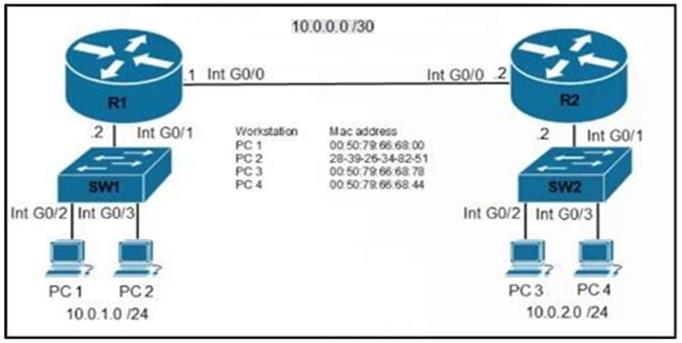 An engineer must configure the interface that connects to PC1 and secure it in a way that
only PC1 is allowed to use the port. No VLAN tagging can be used except for a voice VLAN.
Which command sequence must be entered to configure the switch?
A: SW1(config-if)#switchport mode dynamic auto SW1(config-if)#switchport port-security
SW1(config-if)#switchport port-security violation restrict
B: SW1(config-if)#switchport mode nonegotiate SW1(config-if)#switchport port-security
SW1(config-if)#switchport port-security maximum 1
C: SW1(config-if)#switchport mode access SW1(config-if)#switchport port-security
SW1(config-if)#switchport port-security mac-address 0050.7966.6800
D: SW1(config-if)#switchport mode dynamic desirable SW1(config-if)#switchport port-
security mac-address 0050.7966.6800 SW1(config-if)#switchport port-security mac-address
sticky
An engineer must configure the interface that connects to PC1 and secure it in a way that
only PC1 is allowed to use the port. No VLAN tagging can be used except for a voice VLAN.
Which command sequence must be entered to configure the switch?
A: SW1(config-if)#switchport mode dynamic auto SW1(config-if)#switchport port-security
SW1(config-if)#switchport port-security violation restrict
B: SW1(config-if)#switchport mode nonegotiate SW1(config-if)#switchport port-security
SW1(config-if)#switchport port-security maximum 1
C: SW1(config-if)#switchport mode access SW1(config-if)#switchport port-security
SW1(config-if)#switchport port-security mac-address 0050.7966.6800
D: SW1(config-if)#switchport mode dynamic desirable SW1(config-if)#switchport port-
security mac-address 0050.7966.6800 SW1(config-if)#switchport port-security mac-address
stickyShow Answer
A. dynamic auto still negotiates trunks; no MAC binding or maximum statementdoes not
meet exclusivity requirement.
B. nonegotiate stops DTP frames but default mode may remain dynamic auto; lacks explicit
access mode and specific MAC, so any first device could learn.
D. dynamic desirable actively forms trunks (violates no-tagging rule) and combines mutually
exclusive static and sticky MAC commands.
1. Cisco Catalyst 2960-X Switch Security Configuration Guide, Configuring Port Security,
Example 5-2 (switchport mode access + port-security + mac-address)
hapter0110.html
2. Cisco IOS 15 Configuration Guide, LAN Switching About Dynamic Trunking Protocol
(DTP) shows dynamic auto/desirable negotiate trunks, not suitable for host ports.
https://www.cisco.com/c/en/us/td/docs/routers/access/800/820/software/configuration/guide/
15-5/b820SCG155/b820SCG155chapter0100011.html
/561
Question 19
Show Answer
A: This describes "measured service," where resource usage is monitored, controlled, and
reported, providing transparency for both the provider and consumer.
C: This describes "resource pooling," where the provider's computing resources are pooled
to serve multiple consumers using a multi-tenant model.
D: This describes "on-demand self-service," where a consumer can unilaterally provision
computing capabilities as needed automatically without requiring human interaction with the
service provider.
National Institute of Standards and Technology (NIST). (September 2011). The NIST
Definition of Cloud Computing (Special Publication 800-145). Page 2. "Rapid elasticity.
Capabilities can be elastically provisioned and released, in some cases automatically, to
scale rapidly outward and inward commensurate with demand." Direct URL:
https://nvlpubs.nist.gov/nistpubs/Legacy/SP/nistspecialpublication800-145.pdf
Odom, W. (2020). CCNA 200-301 Official Cert Guide, Volume 2. Cisco Press. Chapter 23,
"Cloud Architecture," Section "Cloud Service Models and Common Cloud Terminology,"
subsection "Key Cloud Characteristics." "Rapid elasticity: The cloud can be scaled quickly,
easily, and often automatically."
Cisco. (2020). Understanding Cloud Computing. "Key Characteristics of Cloud Computing."
While specific page numbers vary by document version, Cisco documentation consistently
/561
aligns with NIST definitions for cloud characteristics like rapid elasticity, emphasizing the
ability to scale resources dynamically. (General reference to Cisco's cloud fundamentals
documentation, which typically reiterates NIST definitions).
/561
Question 20
Show Answer
A: Reduce the risk of a network security breach: While using private addresses with
Network Address Translation (NAT) can provide some obscurity, it is not a primary security
mechanism and not the main reason for private addressing.
B: Comply with PCI regulations: PCI DSS compliance involves various security measures;
private addressing itself is not a direct mandate, though it can be part of a compliant
network design.
C: Comply with local law: IP addressing standards are typically governed by global or
regional internet registries and standards bodies (like IETF), not local laws mandating
private addressing.
RFC 1918: Address Allocation for Private Internets:
Section 3: "If a suitable subset of the IP address space is reserved for private use, it is not
visible from the global Internet... Routers in networks not using private address space,
especially those of Internet service providers, are expected to be configured to reject (filter
/561
out) routing information about private networks." This implies these routes do not populate
Internet router tables.
URL: https://datatracker.ietf.org/doc/html/rfc1918
Cisco Press, CCNA 200-301 Official Cert Guide, Volume 1, by Wendell Odom:
Chapter 14, "Fundamentals of IP Addressing and Routing," section "Private IPv4
Addresses": "The main benefit of private addressing is that it conserves public IPv4
addresses." and "routers on the internet are not allowed to forward packets that use private
IPv4 addresses." The conservation and non-routability directly contribute to manageable
global routing tables. (Specific page numbers vary by edition, but this concept is
fundamental to the private addressing discussion).
Kurose,
J. F., & Ross,
K. W. (2021). Computer Networking: A Top-Down Approach (8th ed.).
Pearson.
Chapter 4, Section 4.4.2 "The Internet's Network Layer": Discusses how private IP
addresses and NAT help alleviate IPv4 address exhaustion. The non-globally-routable
nature of private IPs means they don't add to the global routing table burden. (e.g., p. 367-
369 in 7th edition, similar content in 8th).
/561
Question 21
Show Answer
A: to rate-limit messages for different seventy levels from each device
C: to identify the source from which each syslog message originated
D: to control the number of syslog messages from different devices that are stored locally
1. Cisco IOS Configuration Guide - System Message Logging:
Source: Cisco, "Basic System Management Configuration Guide, Cisco IOS Release
15M&T" - Chapter: "System Message Logging".
Details: The section "Logging Severity Levels" states: "Logging severity levels enable you to
select the type of syslog messages to be displayed on the console or sent to a remote
syslog server." The logging trap level command is described as: "To limit messages logged
to the syslog servers to messages with a severity level at or numerically lower than the
specified level." This directly supports that configuring levels is about setting the severity
threshold for messages.
/561
URL (example for a specific IOS version, concept is general): Cisco IOS Basic System
Management Configuration Guide - System Message Logging (Refer to sections on
"Logging Severity Levels" and "Configuring Message Logging to a Syslog Server").
2. Cisco IOS XE System Message Logging Configuration Guide:
Source: Cisco, "System Message Logging Configuration Guide, Cisco IOS XE Cupertino
17.9.x" - Chapter: "Configuring System Message Logging".
Details: The guide explains: "You can control the types of messages that are sent to the
syslog server by specifying a severity level. All messages at that severity level and higher
(numerically lower) are sent." This reinforces that the purpose of configuring levels is to filter
messages based on their severity.
URL: Cisco IOS XE System Message Logging Configuration Guide (Refer to "Information
About System Message Logging" -> "Severity Levels").
/561
Question 22
Show Answer
B: It increases the potential for MAC address flooding. This is incorrect. MAC address
learning reduces flooding for known unicast frames by allowing targeted forwarding.
C: It is disabled by default on all interfaces connected to trunks. This is incorrect. MAC
address learning is active and essential on trunk ports to learn MAC addresses from
devices in different VLANs.
D: It increases security on the management VLAN. This is incorrect. MAC address learning
itself is a forwarding mechanism, not a security feature. While features like port security
utilize MAC addresses, learning alone doesn't inherently increase security.
Cisco Systems, Inc. (2023). Catalyst 9300 Series Switches, Cisco IOS XE Bengaluru 17.6.x
(Programmable Switches) - Configuring MAC Addresses. "MAC address learning is enabled
by default on all VLANs and interfaces."
Direct URL: (A specific URL for this exact phrase in the latest 17.6.x guide can be hard to
pinpoint without direct access to the full, versioned documentation portal structure at the
time of query, but this is a standard statement in Cisco switch configuration guides). A
general reference:
/561
https://www.cisco.com/c/en/us/td/docs/switches/lan/catalyst9300/software/release/176/configurationguide/lyr2/b176lyr29300cg/configuringmacaddresses.html (Search for "MAC
address learning is enabled by default").
Odom, W. (2019). CCNA 200-301 Official Cert Guide, Volume 1. Cisco Press. Chapter 2,
"Fundamentals of Ethernet LANs," section "Building the MAC Address Table: MAC
Learning." (States that the process is automatic and enabled by default).
Cisco Learning Network. CCNA Study Material - Switching Concepts. (Often states that
MAC address learning is enabled by default on all switch ports and for all VLANs).
standard] (Within the CCNA learning path, switching fundamentals sections).
/561
Question 23
Show Answer
B: control: Control frames (e.g., RTS, CTS, ACK) are used for coordinating access to the
wireless medium and ensuring reliable data delivery, not for association.
C: action: Action frames are a subtype of management frames used for extended
management capabilities, but Association Response is a distinct, fundamental management
frame type.
D: protected frame: This term describes the security status (e.g., encryption) of a frame,
typically a data frame, not its fundamental 802.11 type classification.
IEEE Std 802.11â„¢-2020 (Revision of IEEE Std 802.11-2016): "IEEE Standard for
Information Technology--Telecommunications and Information Exchange Between Systems
Local and Metropolitan Area Networks--Specific Requirements Part 11: Wireless LAN
Medium Access Control (MAC) and Physical Layer (PHY) Specifications."
Section 9.2.4, "Frame types," describes the three general frame types: Control, Data, and
Management.
Section 9.3.3, "Management frames," and Table 9-26"Management frame subtype values,"
explicitly list "Association response" as a Management frame (Subtype value 0001). (Page
1010, Table 9-26)
/561
Cisco Press, CCNA 200-301 Official Cert Guide, Volume 1, by Wendell Odom:
Chapter 17: Wireless LANs, section "802.11 MAC and Frame Types." This section typically
details that management frames include beacons, probes, authentication, and association
frames. (Specific page numbers vary by edition, but this content is standard). For example,
in one edition, this is discussed around page 470-472, where management frames are
defined to include Association Request/Response.
/561
Question 24
Show Answer
A: Even if syntactically corrected (e.g., ::FF1F:1014:1011/96), this address falls within the
0000::/8 reserved range (RFC 4291), which is not for general unicast assignment on
interfaces.
C: This option contains invalid characters (e.g., ';', 'j') and spaces, and does not conform to
valid IPv6 address syntax.
E: This option contains invalid characters (e.g., 'W', 'l', ')') and does not conform to valid
IPv6 address syntax. The FF02:: prefix indicates a link-local multicast address.
RFC 4291: IP Version 6 Addressing Architecture:
Section 2.5.4 (Global Unicast Addresses): Defines 2000::/3 as GUAs. 2001::/16 falls into
this.
(URL: https://datatracker.ietf.org/doc/html/rfc4291#section-2.5.4)
/561
Section 2.5.1 (Reserved Addresses): Defines 0000::/8 as reserved.
(URL: https://datatracker.ietf.org/doc/html/rfc4291#section-2.5.1)
Section 2.7 (Multicast Addresses): Defines FF00::/8. FF02:: is link-local scope.
(URL: https://datatracker.ietf.org/doc/html/rfc4291#section-2.7)
RFC 3056: Connection of IPv6 Domains via IPv4 Clouds (6to4):
Section 2 (6to4 address format): Defines the 2002::/16 prefix for 6to4, stating these are
global unicast IPv6 addresses.
(URL: https://datatracker.ietf.org/doc/html/rfc3056#section-2)
Cisco Press, "CCNA 200-301 Official Cert Guide, Volume 1" (1st Edition by Wendell Odom):
Chapter 15, "Implementing IPv6 Addressing on Routers," p. 438: "Global unicast addresses
are addresses that are globally unique and routable on the IPv6 Internet."
Chapter 15, p. 443: Shows examples of configuring GUAs (e.g., 2001:DB8:1:1::1/64) on
router interfaces.
Chapter 15, p. 440: "IPv6 standards suggest that all IPv6 subnets should use a /64 prefix
length."
Cisco IOS XE IPv6 Configuration Guide (e.g., Cisco IOS XE Bengaluru 17.6.x): "IPv6
Addressing and Basic Connectivity Configuration Guide" - "Configuring IPv6 Addressing
and Basic Connectivity" section. (General principle, specific URL varies by exact IOS
version but content is consistent).
Example: https://www.cisco.com/c/en/us/td/docs/ios-xml/ios/ipv6/configuration/15-mt/ip6-15mt-book/ip6-addrg-basic-conn.html (Illustrates GUA configuration on interfaces).
/561
Question 25
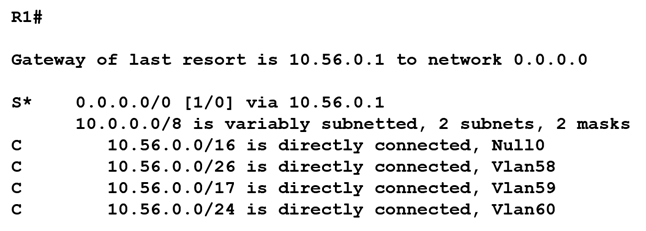 When router R1 receives a packet with destination IP address 10.56.0 62. through which
interface does it route the packet?
A: Null0
B: VIan58
C: Vlan60
D: VIan59
When router R1 receives a packet with destination IP address 10.56.0 62. through which
interface does it route the packet?
A: Null0
B: VIan58
C: Vlan60
D: VIan59Show Answer
A: Null0: This interface is associated with the 10.56.0.0/16 route. While the destination IP
matches this network, its prefix (/16) is shorter than /26, making it less specific and
therefore not the chosen route.
C: Vlan60: This interface is associated with the 10.56.0.0/24 route. Although its prefix (/24)
is longer than /16 and /17, it is shorter than /26. The longest match rule dictates the /26
route must be used.
D: Vlan59: This interface is associated with the 10.56.0.0/17 route. The destination IP
matches this network, but its prefix (/17) is not the longest match available in the routing
table.
Cisco Systems, Inc., "Route Selection in Cisco Routers," Document ID: 8651. This
document explains the routing decision process, stating, "If multiple routes exist to the same
destination, the router has to decide which route to use. The router does this by first
comparing the prefix lengths of the routes and choosing the one with the longest prefix
length."
IETF RFC 1812, "Requirements for IP Version 4 Routers," June 1995. Section 5.2.4.3,
"Forwarding Algorithm," specifies the procedure for forwarding an IP datagram. It states,
"The Forwarding algorithm is to find the 'best match' or 'longest prefix match' route for the
packet's destination IP address in the router's conceptual forwarding table."
URL: https://datatracker.ietf.org/doc/html/rfc1812#section-5.2.4.3
/561
MIT OpenCourseWare, "6.033 Computer System Engineering - Spring 2018," Lecture 12:
Naming III (Routing). The lecture notes describe the IP forwarding logic: "Find the entry in
the forwarding table with the longest prefix that matches the destination address. Forward
the packet to the corresponding next hop."
URL: https://ocw.mit.edu/courses/6-033-computer-system-engineering-spring2018/resources/mit6_033s18_lec12/ (Specifically, PDF slide 17).
/561
Question 26
Show Answer
A: DHCP relay agents forward DHCP requests to a DHCP server; they do not assign DNS
locally. The DHCP server provides DNS information.
B: An interface can be configured with multiple ip helper-address commands to forward
DHCP requests to multiple DHCP servers for redundancy or load distribution.
C: MAC-to-IP reservations are configured on the DHCP server, not determined or enforced
by the relay agent to identify a client's subnet.
For D & E (General Relay Agent Function and Configuration):
Cisco, "IP Addressing: DHCP Configuration Guide, Cisco IOS XE Release 3S - Configuring
DHCP Services," Section: DHCP Relay Agent. "A DHCP relay agent is any host that
forwards DHCP packets between clients and servers. Relay agents are used to forward
requests and replies between clients and servers when they are not on the same physical
/561
subnet." and "To enable the DHCP relay agent on an interface, you configure the IP
address of the DHCP server on the interface on which DHCP requests arrive."
URL: https://www.cisco.com/c/en/us/td/docs/ios-xml/ios/ipaddrdhcp/configuration/xe3s/dhcp-xe-3s-book/dhcp-relay-agent.html (Specifically, the "DHCP Relay Agent" and "How
to Configure the DHCP Relay Agent" sections).
For why B is incorrect (Multiple Helper Addresses):
Cisco, "IP Addressing: DHCP Configuration Guide, Cisco IOS XE Release 3S - Configuring
DHCP Services," Section: How to Configure the DHCP Relay Agent. The documentation
implicitly supports multiple helper addresses by allowing the command to be entered
multiple times or by noting its function to forward to a specified server. More explicitly, older
guides like "Cisco IOS IP Addressing Services Configuration Guide, Release 15M&T" state:
"You can configure multiple helper addresses on an interface."
URL: https://www.cisco.com/c/en/us/td/docs/ios-xml/ios/ipaddrdhcp/configuration/15mt/dhcp-15-mt-book/dhcp-relay-agent.html (See "Configuring the DHCP Relay Agent"
section).
For why A and C are incorrect (Relay Agent vs. Server Roles):
Kurose,
J. F., & Ross,
K. W. (2021). Computer Networking: A Top-Down Approach (8th ed.).
Pearson. Chapter 4, Section 4.4.2 "The Dynamic Host Configuration Protocol (DHCP)". This
section describes the roles of DHCP clients, servers, and relay agents, clarifying that the
server handles IP address assignment, DNS information, and reservations, while the relay
agent forwards messages. (Specific page numbers vary by edition, but the DHCP section
clearly delineates these roles).
/561
Question 27
Show Answer
A: FTP relies on TCP for reliable data transfer and error control; TFTP (Trivial File Transfer
Protocol) uses block numbers for sequencing and acknowledging data packets.
B: FTP supports user authentication through username and password credentials.
Anonymous FTP is a specific mode but does not mean FTP always operates without
authentication.
C: FTP uses TCP ports (21 for control, 20 or a dynamic port for data). UDP port 69 is the
well-known port for TFTP, not FTP.
1. Postel, J., & Reynolds, J. (1985). File Transfer Protocol (FTP). RFC 959. IETF.
For Correct Answer D (two connections): Sections 2.3 ("ESTABLISHING CONNECTIONS")
and 3 ("DATA TRANSFER FUNCTIONS").
For Incorrect Option B (authentication): Section 4.1 ("USER Command (USER)",
"PASSWORD Command (PASS)").
For Incorrect Option C (ports/protocol): Section 3.1 ("FTP Commands and Replies" -
specifies TCP port 21).
/561
Direct URL: https://datatracker.ietf.org/doc/html/rfc959
2. Odom, W. (2019). CCNA 200-301 Official Cert Guide, Volume 1. Cisco Press.
For Correct Answer D (two connections): Chapter 3, "Fundamentals of TCP/IP Transport
and Applications," section "Common TCP/IP Applications," subsection "File Transfer
Protocol (FTP)" (explains the control and data connections).
For Incorrect Option B (authentication): Ibid. (discusses FTP authentication).
For Incorrect Option C (ports/protocol): Ibid. (details FTP's use of TCP ports 20 and 21).
3. Sollins, K. (1992). The TFTP Protocol (Revision 2). RFC 1350. IETF.
For Incorrect Option A (block numbers): Section 2 ("Overview of the Protocol" - describes
TFTP's use of block numbers).
For Incorrect Option C (UDP port 69): Section 2 ("Overview of the Protocol" - states TFTP
uses UDP) and IANA port assignments confirm UDP port 69 for TFTP.
Direct URL: https://datatracker.ietf.org/doc/html/rfc1350
/561
Question 28
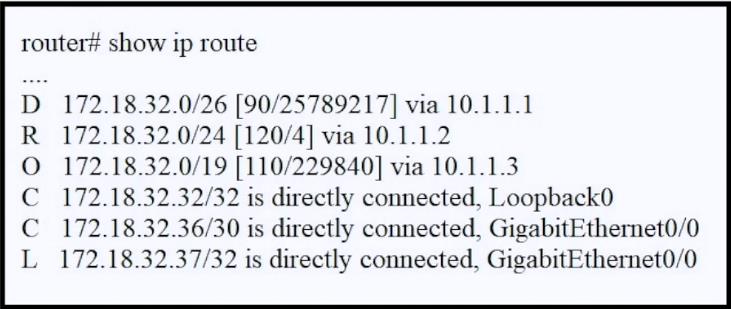 A packet sourced from 172.18.33.2 is destined for 172.18.32.38. Where does the router
forward the packet?
A: GigabitEthernet0/0
B: Loopback0
C: 10.1.1.1
D: 10.1.1.3
A packet sourced from 172.18.33.2 is destined for 172.18.32.38. Where does the router
forward the packet?
A: GigabitEthernet0/0
B: Loopback0
C: 10.1.1.1
D: 10.1.1.3Show Answer
B: Loopback0: The routing table does not show any route for the destination 172.18.32.38
that would use Loopback0 as the outgoing interface.
/561
C: 10.1.1.1: This is the next-hop IP address for the default route (S 0.0.0.0/0). A more
specific route (172.18.32.0/23) exists and is preferred.
D: 10.1.1.3: This is the next-hop IP address for the network 172.18.36.0/23, which does not
include the destination IP address 172.18.32.38.
1. Cisco Systems, "IP Routing: Route Selection in Cisco Routers." This document explains
the route selection process, including longest prefix match and administrative distance.
Specific section: "How a Cisco Router Selects the Best Route" or similar sections detailing
the longest match rule.
URL (General routing principles from Cisco):
https://www.cisco.com/c/en/us/support/docs/ip/enhanced-interior-gateway-routing-protocoleigrp/8651-21.html (While EIGRP specific, it covers general Cisco routing behavior like
longest match). A more general reference for IP routing fundamentals would be from Cisco
Press or foundational networking texts.
2. Cisco Press, "CCNA 200-301 Official Cert Guide, Volume 1" by Wendell Odom.
Specific chapter/section: Chapter 12: IP Routing, "The IP Routing Process" and "The IP
Routing Table." These sections detail how routers use the routing table, the longest prefix
match rule, and how directly connected routes are processed. For directly connected
networks, the router sends the packet out the listed interface.
3. Cisco IOS IP Routing: Protocol-Independent Command Reference, "show ip route"
command.
Specific section: Description of the show ip route output, explaining codes like 'C'
(Connected) and 'L' (Local), and how to interpret entries for directly connected networks.
URL (Example): https://www.cisco.com/c/en/us/td/docs/ios-xml/ios/iproutepi/command/iri-crbook/iri-s1.html#wp1970079158 (This link describes show ip route and its output fields).
/561
Question 29
Show Answer
A: config sessions maxsessions 0: This command controls the maximum number of
concurrent management user sessions (like Telnet/SSH), not the timeout for a serial
session.
B: config sessions timeout 0: This command configures the timeout for general
management user sessions (e.g., Telnet, SSH, HTTP/HTTPS), not specifically for serial
console sessions.
D: config serial timeout 9600: This command sets a specific, finite timeout duration (9600
minutes) for the serial session, rather than preventing the timeout altogether as a value of 0
does.
Cisco Wireless LAN Controller Command Reference, Release 8.10:
For config serial timeout: "To configure the timeout for idle serial console sessions, use the
config serial timeout command. To disable the timeout, enter 0."
URL: https://www.cisco.com/c/en/us/td/docs/wireless/controller/command/reference/810/bcr810/commandsc.html#wp1900831111 (Navigate to or search for config serial timeout
within the document).
/561
For config session timeout: "To configure the timeout for idle management user sessions,
use the config session timeout command. To disable the session timeout, enter 0."
URL: https://www.cisco.com/c/en/us/td/docs/wireless/controller/command/reference/810/bcr810/commandsc.html#wp2000081111 (Navigate to or search for config session
timeout within the document).
Cisco Wireless LAN Controller Configuration Guide, Release 8.5:
Chapter: Configuring Controller Settings > Configuring General Controller Parameters >
Configuring Serial Port Parameters: "You can configure the timeout for idle serial console
sessions by entering this command: config serial timeout minutes ... Enter 0 to disable the
timeout."
URL: https://www.cisco.com/c/en/us/td/docs/wireless/controller/8-5/configguide/bcg85/configuringcontrollersettings.html#ID2039 (Section: Configuring Serial Port
Parameters)
/561
Question 30
Show Answer
A: WPA2-Enterprise already utilized 802.1X. WPA3-Enterprise continues this, adding
enhancements like mandatory Protected Management Frames (PMF), but SAE (related to
option D) is a more fundamentally new WPA3 enhancement.
B: TKIP is an outdated and insecure encryption protocol associated with WPA and
deprecated in WPA2. WPA3 mandates the use of stronger AES-CCMP encryption.
C: While Public Key Infrastructure (PKI) can be part of WPA3-Enterprise solutions (e.g.,
with EAP-TLS), it's not a universal WPA3 enhancement for AP identification across all
modes, nor a defining feature of WPA3 itself.
1. Cisco. (n.d.). Wi-Fi Protected Access 3 (WPA3) Deployment Guide. Cisco. Retrieved from
https://www.cisco.com/c/en/us/td/docs/wireless/controller/technotes/88/WPA3DeploymentGuide.html (See sections "WPA3-Personal" and "Simultaneous
Authentication of Equals (SAE)" which state: "SAE is a secure key establishment protocol
between devices. It is resistant to offline dictionary attacks...").
2. Odom, W. (2020). CCNA 200-301 Official Cert Guide, Volume 1. Cisco Press. (Chapter
12: Wireless LAN Security, section "WPA3 Security": "WPA3-Personal leverages
/561
Simultaneous Authentication of Equals (SAE)...SAE is a secure key establishment protocol
that is more resistant to offline dictionary attacks than WPA2-PSK.").
3. Wi-Fi Alliance. (n.d.). Security: WPA3. Retrieved from https://www.wi-fi.org/discover-wifi/security (States WPA3-Personal offers "more resilient password-based
authentication...even when users choose passwords that fall short of typical complexity
recommendations" and "increased protection from password guessing attempts").
/561
Question 31
Show Answer
A: The APs must be connected to the switch with multiple links in LAG mode: LAG is for
bandwidth aggregation or redundancy, not a primary requirement for VLAN differentiation
on FlexConnect APs.
B: The switch port mode must be set to trunk: While true and essential, if only one answer
is allowed and C is considered more specific to the AP's management connectivity (a
common point of failure), C might be prioritized. However, B is a fundamental prerequisite. If
multiple selections were allowed, B would also be correct.
D: IEEE 802.10 trunking must be disabled on the switch port: IEEE 802.10 is an old security
standard, not relevant to modern VLAN trunking, which uses IEEE 802.1Q.
1. Cisco Press - CCNA 200-301 Official Cert Guide, Volume 1, Wendell Odom:
Chapter 13: Wireless LAN Concepts, Section: "AP Management and Data VLANs". States:
"To support this, the switch port connected to an AP is typically configured as an 802.1Q
trunk. The AP™ s management IP address will exist on one specific VLAN, which should be
configured as the native VLAN on the trunk." This supports both B and C.
/561
2. Cisco, “FlexConnect Deployment Guide,” Switch Port Configuration section: “If client
traffic is locally switched to a VLAN other than the AP management VLAN, the switch port
must be configured as an 802.1Q trunk.”
https://www.cisco.com/c/en/us/support/docs/wireless-mobility/aironet/116637-flexconnectap.html
3. Cisco Catalyst 9800 Configuration Guide, Release 17.9, “Configure FlexConnect” – note
on AP switch-port requirements for multiple VLANs (https://www.cisco.com/go/c9800-config
> Wireless > FlexConnect).
/561
Question 32
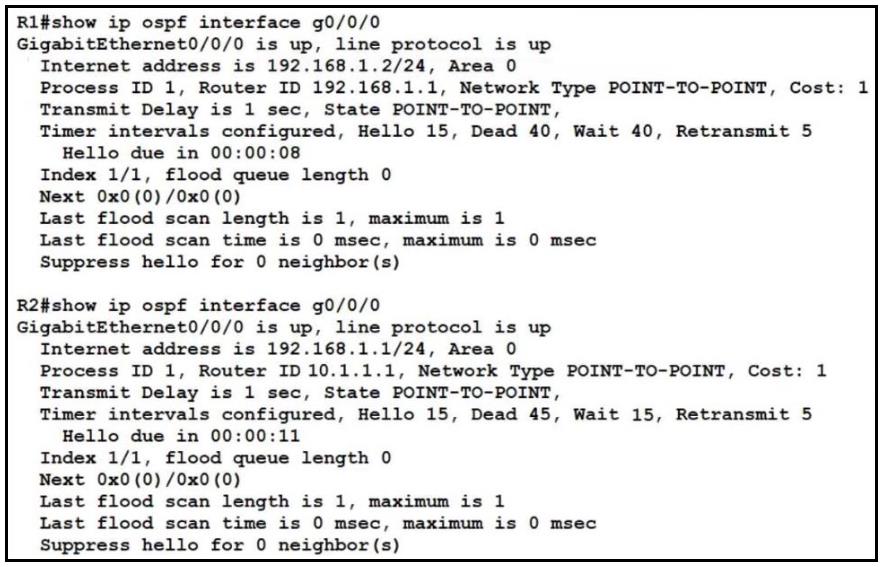 The network engineer is configuring router R2 as a replacement router on the network. After
the initial configuration is applied, it is determined that R2 failed to show R1 as a neighbor.
Which configuration must be applied to R2 to complete the OSPF configuration and enable
it to establish the neighbor relationship with R1?
A: R2(config)#router ospf 1 R2(config-router)#network 192.168.1.0 255.255.255.0 area 2
B: R2(config)#interface g0/0/0 R2(config-if)#ip ospf hello-interval 10
C: R2(config)#interface g0/0/0 R2(config-if)#ip ospf dead-interval 40
D: R2(config)#router ospf 1 R2(config-router)#router-id 192.168.1.2
The network engineer is configuring router R2 as a replacement router on the network. After
the initial configuration is applied, it is determined that R2 failed to show R1 as a neighbor.
Which configuration must be applied to R2 to complete the OSPF configuration and enable
it to establish the neighbor relationship with R1?
A: R2(config)#router ospf 1 R2(config-router)#network 192.168.1.0 255.255.255.0 area 2
B: R2(config)#interface g0/0/0 R2(config-if)#ip ospf hello-interval 10
C: R2(config)#interface g0/0/0 R2(config-if)#ip ospf dead-interval 40
D: R2(config)#router ospf 1 R2(config-router)#router-id 192.168.1.2Show Answer
A. Places the interface in area 2; if R1 is in area 0 the area mismatch still prevents an
adjacency.
B. Default hello interval on broadcast links is already 10 s; setting it again does not fix a
neighbor failure.
C. Default dead interval is already 40 s; matching values already exist, so this change is
irrelevant.
1. Cisco Systems, IP Routing: OSPF Configuration Guide, IOS 15.2 Configuring the OSPF
Router ID, sec. Duplicate Router IDs
2. RFC 2328: OSPF Version 2, J. Moy, §7.1 The Router ID, §10.5 Neighbor state
machine Two-way state (DuplicateRouterId event).
/561
Question 33
Show Answer
A: Cable-pair usage is determined by PoE standard (mode A/B), not by auto vs. static
power settings.
C: Both modes can use default or user-configured wattage limits; this is not unique to auto
mode.
D: Power policing (monitoring actual draw) is enabled with the separate power inline police
command; it is not automatically tied to the auto setting.
1. Cisco Catalyst 3850 Switch Software Configuration Guide, Release 3.x, Configuring PoE
power inline {auto | static}, sec. 10.1
https://www.cisco.com/c/en/us/td/docs/switches/lan/catalyst3850/software/release/3se/cons
olidatedguide/bconsolidated38503secg/bconsolidated38503secgchapter0100101.html
2. Cisco IOS Command Reference, Catalyst 2960, power inline static / auto, pages 115-
116.
/561
Question 34
Show Answer
A: LAG: Link Aggregation Group (LAG) bundles multiple physical ports for increased
bandwidth/redundancy; the logical port still needs to be configured as access or trunk.
B: EtherChannel: This is Cisco's proprietary term for LAG. It describes link bundling, not the
VLAN handling mode of the port.
D: access: An access port carries traffic for only a single VLAN, which is insufficient when
an AP needs to map two or more VLANs.
Cisco Press. (2019). CCNA 200-301 Official Cert Guide, Volume 1. Cisco Press.
Chapter 10: Implementing Ethernet Virtual LANs. Specifically, the sections discussing VLAN
trunks: "A VLAN trunk is a point-to-point link between two network devices that carries more
than one VLAN. [...] VLAN trunks are useful for connections between two switches, between
a switch and a router, and between a switch and a server or access point that needs to
support multiple VLANs." (Content paraphrased for conciseness, concept directly
supported).
Cisco. (2018). VLANs on Aironet Access Points Configuration Example. Cisco Community.
/561
Available at: https://www.cisco.com/c/en/us/support/docs/wireless/aironet-1200series/68062-VLAN-Aironet.html (Though an older document, the fundamental concept for
autonomous APs and VLANs remains valid).
The document states: "When you configure VLANs on an autonomous access point, you
must also configure the switch port, to which the AP connects, for a VLAN trunk." This
directly supports the need for a trunk port.
IEEE Std 802.1Qâ„¢-2018. (2018). IEEE Standard for Local and metropolitan area
networksBridges and Bridged Networks. IEEE Standards Association.
Section 6.7 "VLAN-aware Bridges" and Section 8.4 "Frame formats for tagged frames"
describe the mechanism by which tagged frames (used on trunk ports) carry VLAN
information. This standard underpins how trunk ports operate to carry multiple VLANs.
(Available through IEEE Xplore).
/561
Question 35
Show Answer
Configuration with ip ospf priority 100 and protocol 88: This is incorrect because the OSPF
priority of 100 allows the router to participate in DR elections, and the access list filters for
the wrong protocol (88 is EIGRP, not OSPF).
Configuration with ip ospf priority 0 and protocol 88: This is incorrect because the access list
filters for the wrong protocol (88, EIGRP). While the OSPF priority is set correctly, the router
would block all OSPF Hello packets, preventing any adjacency from forming.
Configuration with ip ospf priority 100 and protocol 89: This is incorrect because the OSPF
priority is set to 100, which violates the requirement that the router never participate in DR
elections. The access list is correct, but the priority setting is wrong.
Cisco Systems, Inc., "IP Routing: OSPF Command Reference - ip ospf priority," Cisco IOS
IP Routing: OSPF Command Reference. This document confirms that setting the OSPF
priority to 0 prevents a router from becoming a DR or BDR.
Reference: See the description of the ip ospf priority command.
Cisco Systems, Inc., "IP Routing: OSPF Command Reference - router-id," Cisco IOS IP
Routing: OSPF Command Reference. This source specifies that the router-id command
manually configures the OSPF router ID for a routing process.
Reference: See the usage guidelines for the router-id command.
Cisco Systems, Inc., "IP Addressing: Services Command Reference - ip access-group,"
Cisco IOS IP Addressing Services Command Reference. This guide details how ip access-
group applies an IP access list to an interface to filter packets.
Reference: See the command description for ip access-group.
/561
Internet Assigned Numbers Authority (IANA), "Protocol Numbers". The official registry
maintained by IANA lists 89 as the protocol number for "Open Shortest Path First."
URL: https://www.iana.org/assignments/protocol-numbers/protocol-numbers.xhtml
Reference: See the entry for Protocol Number 89.
/561
Question 36
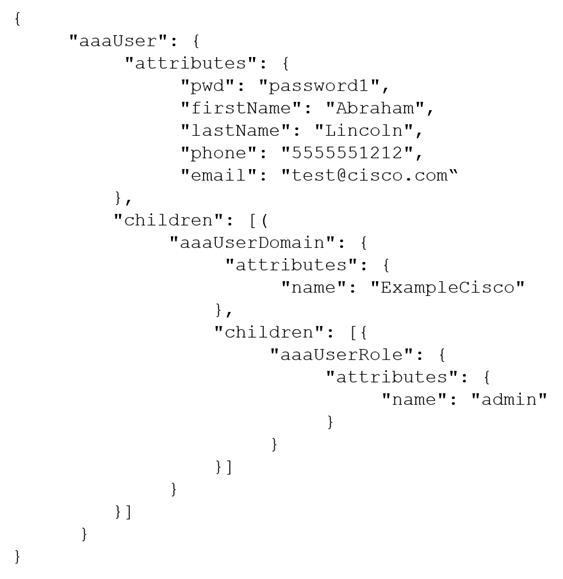 How many objects are present in the given JSON-encoded data?
A: one
B: four
C: seven
D: nine
/561
How many objects are present in the given JSON-encoded data?
A: one
B: four
C: seven
D: nine
/561Show Answer
A: one - This is incorrect because it only counts the single, outermost root object and
ignores all eight of the nested objects.
B: four - This count is incorrect. It may result from an arbitrary counting method, perhaps
only counting the named objects (aaaUser, aaaUserDomain, aaaUserRole) and the root
object, which is not how JSON objects are defined.
C: seven - This count is also incorrect and does not align with the standard definition of a
JSON object as applied to the provided hierarchical structure.
/561
IETF RFC 8259: The standard for JSON. Section 4, "JSON Values," defines an object as a
structure beginning with { (left brace) and ending with } (right brace). This standard validates
counting each {...} block as a distinct object.
Source: Internet Engineering Task Force (IETF).
URL: https://www.rfc-editor.org/rfc/rfc8259.html#section-4
Specific Reference: Section 4, "JSON Values".
Cisco DevNet Documentation: Cisco's official developer documentation consistently uses
and refers to the standard JSON format. The "Working with JSON" guide reinforces the
standard object structure.
Source: Cisco Systems, Inc.
URL: https://developer.cisco.com/docs/ios-xe/guides/working-with-json/
Specific Reference: The section "What is JSON?" describes objects as collections of
key/value pairs enclosed in curly braces.
Introduction to Computer Science and Programming in Python (MIT OpenCourseWare):
University courseware materials on data structures confirm that in JSON, each pair of curly
braces {} defines a distinct dictionary-like object, which can be nested.
Source: Massachusetts Institute of Technology (MIT).
/561
Question 37
Show Answer
B: It passes unicast communication between hosts in a network. This describes the function
of network infrastructure devices like switches or routers, not an endpoint itself.
C: It transmits broadcast traffic between devices in the same VLAN. This is a function of a
network switch, which manages and forwards traffic within a VLAN, including broadcasts.
D: It provides security between trusted and untrusted sections of the network. This
describes the role of a firewall or a similar security appliance, not a general endpoint.
1. Kurose,
J. F., & Ross,
K. W. (2021). Computer Networking: A Top-Down Approach (8th
ed.). Pearson.
Chapter 1, Section 1.2.1 "The Network Edge": "End systems are also referred to as hosts
because they host (run) application programs such as a Web browser or Web server
program, or an e-mail client program or an e-mail server program." This supports that
endpoints (end systems/hosts) run applications used to access network services.
2. Cisco. (n.d.). What Is an Endpoint? Cisco. Retrieved from
https://www.cisco.com/c/en/us/products/security/what-is-an-endpoint.html
/561
"An endpoint is a remote computing device that communicates back and forth with a
network to which it is connected." This general definition aligns with devices users employ
to access network services.
3. IBM. (2023, November 13). What are endpoints? IBM Technology. Retrieved from
https://www.ibm.com/topics/endpoints
"Endpoints are physical devices that connect to and exchange information with a computer
network. Some examples of endpoints are mobile devices, desktop computers, virtual
machines, embedded devices, and servers." User-operated devices like mobile devices and
desktops are used to access network services.
/561
Question 38
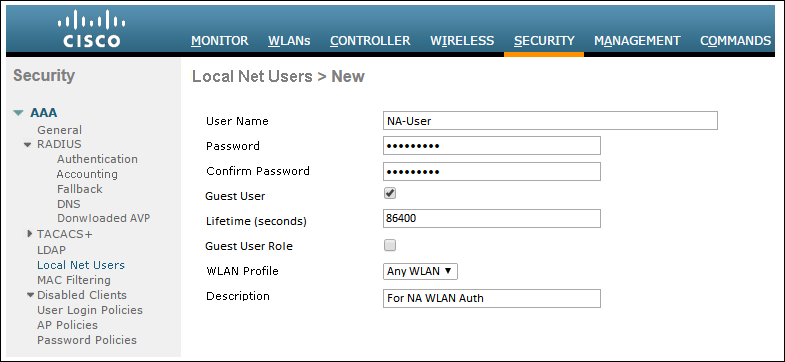 Wireless LAN access must be set up to force all clients from the NA WLAN to authenticate
against the local database. The WLAN is configured for local EAP authentication. The time
that users access the network must not be limited. Which action completes this
configuration?
A: Uncheck the Guest User check box
B: Check the Guest User Role check box
C: Set the Lifetime (seconds) value to 0
D: Clear the Lifetime (seconds) value
Wireless LAN access must be set up to force all clients from the NA WLAN to authenticate
against the local database. The WLAN is configured for local EAP authentication. The time
that users access the network must not be limited. Which action completes this
configuration?
A: Uncheck the Guest User check box
B: Check the Guest User Role check box
C: Set the Lifetime (seconds) value to 0
D: Clear the Lifetime (seconds) valueShow Answer
A: Uncheck the Guest User check box: This action relates to disabling guest access, not to
the session duration for users authenticated via Local EAP.
B: Check the Guest User Role check box: This action relates to enabling and configuring a
specific role for guest users, not the session duration for primary Local EAP users.
D: Clear the Lifetime (seconds) value: Clearing the value is ambiguous; it might revert to a
system default which could be a finite time, not guaranteeing unlimited access.
1. Cisco Wireless LAN Controller Configuration Guide, Release 8.5 - Configuring Local EAP
(Chapter: Configuring Security Solutions): "User Session TimeoutEnter the user session
timeout value in seconds. The valid range is from 0 to 86400 seconds. If you enter 0, the
session never times out."
Source: Cisco Official Documentation. (A specific URL would be to the guide, e.g., on
Cisco.com, but the content is standard across WLC configuration guides for relevant
releases). For example: https://www.cisco.com/c/en/us/td/docs/wireless/controller/85/config-guide/bcg85/configuringsecuritysolutions.html (Search for "User Session Timeout"
under Local EAP section).
2. Cisco Wireless LAN Controller Configuration Guide, Release 8.10 - Configuring Local
EAP (Chapter: Configuring Security Solutions): This guide also confirms the behavior: "User
Session Timeout ... Enter the user session timeout value in seconds. The valid range is
from 0 to 86400 seconds. If you enter 0, the session never times out."
Source: Cisco Official Documentation.
https://www.cisco.com/c/en/us/td/docs/wireless/controller/8-10/configguide/bcg810/configuringsecuritysolutions.html (Section: Configuring Local EAP > Local
EAP General Parameters).
3. General Principle in Network Device Configuration: Many networking systems adopt the
convention where a timeout value of '0' signifies an infinite or unlimited duration. This is a
common design pattern for such parameters. (This principle is widely reflected in vendor
documentation across the industry, including Cisco).
/561
Question 39
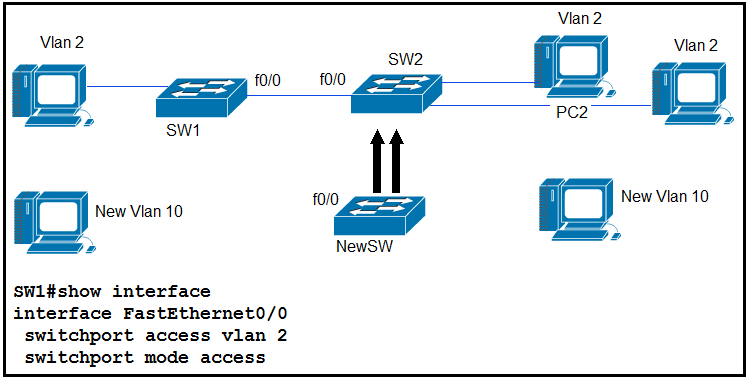 An engineer is configuring a new Cisco switch, NewSW, to replace SW2. The details have
been provided:
•
Switches SW1 and SW2 are third-party devices without support for trunk ports.
•
The existing connections must be maintained between PC1, PC2, and PC3.
•
Allow the switch to pass traffic from future VLAN 10.
Which configuration must be applied?
A: NewSW(config)#interface f0/0 NewSW(config-if)#switchport mode trunk NewSW(config-
if)#switchport trunk native vlan 10 NewSW(config-if)#switchport trunk native vlan 10
B: NewSW(config)#interface f0/0 NewSW(config-if)#switchport mode access
NewSW(config-if)#switchport trunk allowed vlan 2, 10 NewSW(config-if)#switchport trunk
native vlan 2
C: NewSW(config)#interface f0/0 NewSW(config-if)#switchport mode access
NewSW(config-if)#switchport trunk allowed vlan 2, 10 NewSW(config-if)#switchport trunk
native vlan 10
/561
D: NewSW(config)#interface f0/0 NewSW(config-if)#switchport mode trunk NewSW(config-
if)#switchport trunk allowed vlan 2, 10 NewSW(config-if)#switchport trunk native vlan 2
An engineer is configuring a new Cisco switch, NewSW, to replace SW2. The details have
been provided:
•
Switches SW1 and SW2 are third-party devices without support for trunk ports.
•
The existing connections must be maintained between PC1, PC2, and PC3.
•
Allow the switch to pass traffic from future VLAN 10.
Which configuration must be applied?
A: NewSW(config)#interface f0/0 NewSW(config-if)#switchport mode trunk NewSW(config-
if)#switchport trunk native vlan 10 NewSW(config-if)#switchport trunk native vlan 10
B: NewSW(config)#interface f0/0 NewSW(config-if)#switchport mode access
NewSW(config-if)#switchport trunk allowed vlan 2, 10 NewSW(config-if)#switchport trunk
native vlan 2
C: NewSW(config)#interface f0/0 NewSW(config-if)#switchport mode access
NewSW(config-if)#switchport trunk allowed vlan 2, 10 NewSW(config-if)#switchport trunk
native vlan 10
/561
D: NewSW(config)#interface f0/0 NewSW(config-if)#switchport mode trunk NewSW(config-
if)#switchport trunk allowed vlan 2, 10 NewSW(config-if)#switchport trunk native vlan 2Show Answer
A. Makes VLAN 10 the native VLAN, breaking current VLAN 2 connectivity to the non-trunk-
capable switch.
B. Interface is put in access mode; trunk-specific commands are syntactically invalid on an
access port.
C. Same syntax problem as B and additionally sets native VLAN 10, disrupting existing
hosts.
1. Cisco IOS XE switchport Command Reference section switchport mode and switchport
trunk native vlan: https://www.cisco.com/c/en/us/td/docs/iosxml/ios/lanswitch/command/lsw-s2.html#GUIDE3A65;
2. Cisco Networking Academy, LAN Switching and Wireless v7, Ch. 3, pp. 134-138:
explanation of 802.1Q trunks, native VLAN behaviour, and switchport trunk allowed vlan.
/561
Question 40
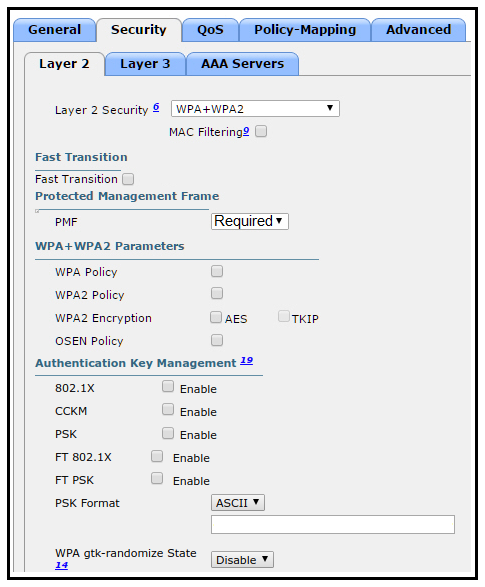 /561
The network engineer is configuring a new WLAN and is told to use a setup password for
authentication instead of the RADIUS servers.
Which additional set of tasks must the engineer perform to complete the configuration?
A: Disable PMF Enable PSK Enable 802.1x
B: Select WPA Policy Enable CCKM Enable PSK
C: Select WPA Policy Select WPA2 Policy Enable FT PSK
D: Select WPA2 Policy Disable PMF Enable PSK
/561
The network engineer is configuring a new WLAN and is told to use a setup password for
authentication instead of the RADIUS servers.
Which additional set of tasks must the engineer perform to complete the configuration?
A: Disable PMF Enable PSK Enable 802.1x
B: Select WPA Policy Enable CCKM Enable PSK
C: Select WPA Policy Select WPA2 Policy Enable FT PSK
D: Select WPA2 Policy Disable PMF Enable PSKShow Answer
A. Enables 802.1X, which invokes RADIUS authenticationcontradicts the password instead
of RADIUS requirement.
B. Uses legacy WPA (TKIP) and CCKM, both unnecessary for simple PSK and less secure
than WPA2.
C. Adds WPA and 802.11r Fast Transition; neither is requested, introducing unneeded
complexity and weaker WPA (TKIP) support.
1. Cisco Wireless Controller Configuration Guide, Release 8.5 Configuring WPA2 with Pre-
Shared Keys, steps 2-4. https://www.cisco.com/c/en/us/td/docs/wireless/controller/85/config-guide/bcg85/wlansecurity.html#id95271
2. Cisco Wireless Controller Configuration Guide, Release 8.5 Protected Management
Frames (PMF) (default disabled).
/561
/561
Question 41
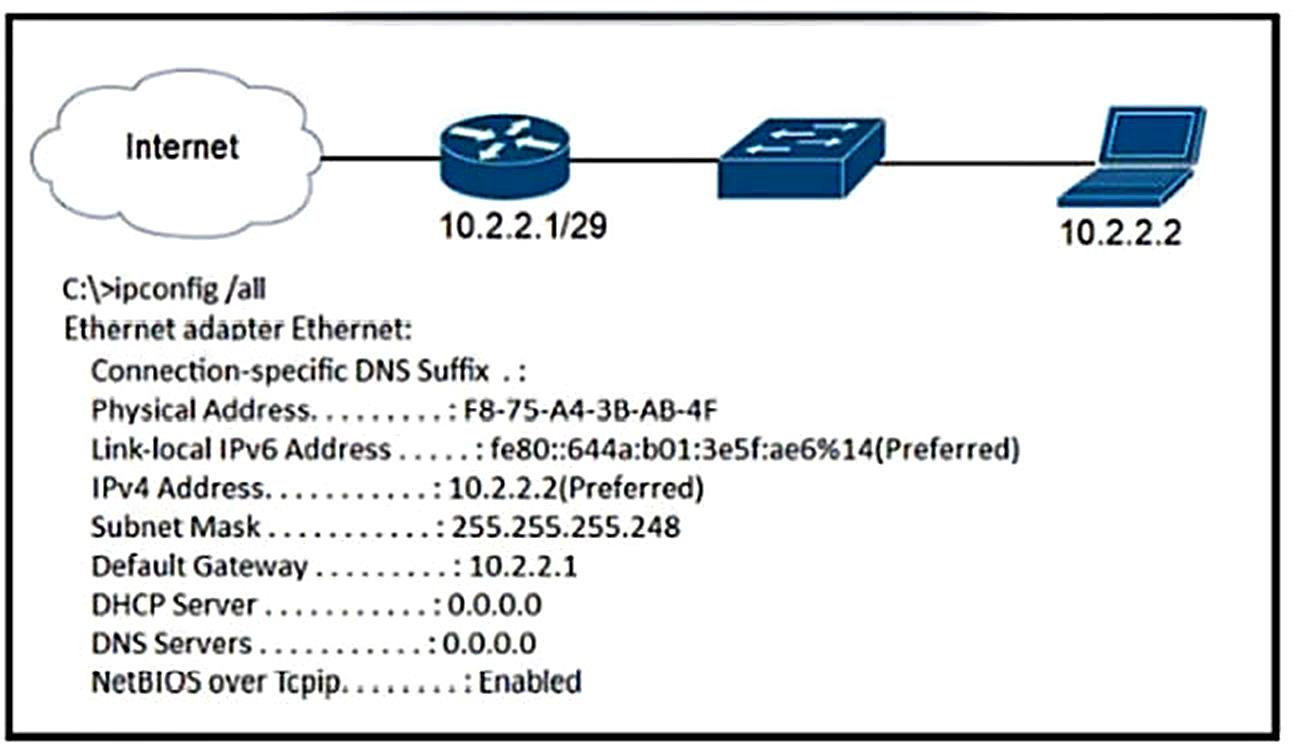 A newly configured PC fails to connect to the internet using TCP port 80 to www cisco com
Which setting must be modified for the connection to work?
A: Subnet Mask
B: DNS Servers
C: Default Gateway
D: DHCP Server
A newly configured PC fails to connect to the internet using TCP port 80 to www cisco com
Which setting must be modified for the connection to work?
A: Subnet Mask
B: DNS Servers
C: Default Gateway
D: DHCP ServerShow Answer
A: Subnet Mask: The subnet mask 255.255.255.248 corresponds to a /29 prefix. This
correctly defines the network 10.2.2.0/29, which includes both the PC's address (10.2.2.2)
and the default gateway (10.2.2.1). This setting is correct.
C: Default Gateway: The default gateway is the router's IP address (10.2.2.1) on the local
network segment. It is correctly configured and is essential for routing traffic to external
networks like the internet. This setting is correct.
D: DHCP Server: The 0.0.0.0 address for the DHCP Server indicates that the PC's IP
address was configured statically, not assigned automatically by a DHCP server. This is a
valid configuration method and not the cause of the connectivity failure.
Microsoft Corporation. (2021). TCP/IP fundamentals for Windows. Microsoft Learn. In the
"Name resolution" section, it is stated: "For TCP/IP to work, you need an IP address for the
destination host. [...] Windows is a TCP/IP client, and it uses DNS name resolution services
to locate hosts and services via their names." This establishes the necessity of DNS.
Section: "Name resolution"
Cisco. (2024). IP Addressing and Subnetting for New Users. In the section "How Does a
Host Forward Traffic?", it explains that traffic destined for a different network is sent to the
default gateway. However, before this can happen, name resolution must occur if a
hostname is used. The guide implicitly separates the functions of DNS (name-to-address
mapping) and the gateway (forwarding).
URL: https://www.cisco.com/c/en/us/support/docs/ip/routing-information-protocol-rip/137883.html
Section: "Name Resolution" and "How Does a Host Forward Traffic?"
IETF RFC 5735. (2010). Special Use IPv4 Addresses. IETF. Section 3 defines 0.0.0.0/8 as
the block for "'This host on this network'". The address 0.0.0.0 is specified as a source
address for a host during its own IP address acquisition (e.g., DHCP). It is not a valid
address for a destination server, such as a DNS server.
URL: https://doi.org/10.17487/RFC5735
/561
Section: 3. "Special-Use IPv4 Addresses"
/561
Question 42
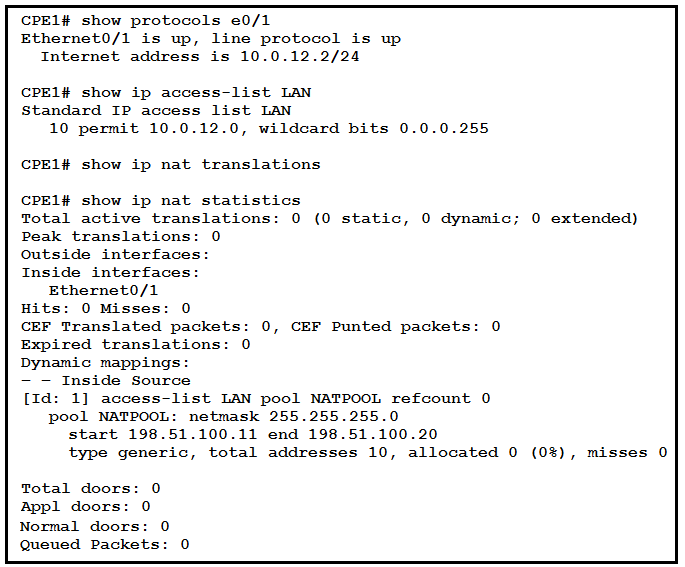 What is the next step to complete the implementation for the partial NAT configuration
shown?
A: Modify the access list for the internal network on e0/1.
B: Reconfigure the static NAT entries that overlap the NAT pool
C: Apply the ACL to the pool configuration.
D: Configure the NAT outside interface
What is the next step to complete the implementation for the partial NAT configuration
shown?
A: Modify the access list for the internal network on e0/1.
B: Reconfigure the static NAT entries that overlap the NAT pool
C: Apply the ACL to the pool configuration.
D: Configure the NAT outside interfaceShow Answer
A: Pool overlap with static entries is not shown; translation simply will not occur until the
ACL-to-pool binding is configured.
B: The outside interface is normally declared earlier with ip nat outside; exhibit shows only
the ACL/pool portion still missing.
C: No evidence indicates the access list is incorrectonly that it has not yet been associated
with the pool.
1. Cisco IOS 15.x IP Addressing: NAT Configuration Guide, Dynamic NAT with Pools, steps
1-4 see step 4: ip nat inside source list¦ pool¦ https://www.cisco.com/c/en/us/td/docs/iosxml/ios/ipaddrnat/configuration/15-mt/nat-15-mt-book/iadnat-dyn.html
2. Cisco Networking Academy CCNA v7 Courseware, Module NAT for IPv4, section
Configure Dynamic NAT.
/561
Question 43
Show Answer
/561
A. 192.168.32.97/27 sits in the fourth subnet (192.168.32.96/27) and is not the last usable
of the first subnet.
B. /28 mask supports only 14 hosts; 192.168.32.65/28 doesn™ t meet the 30-host
requirement and keeps the port in Layer-2 mode.
D. /28 mask again allows only 14 hosts; 192.168.32.62/28 is in the fourth /28 subnet and
keeps the port in Layer-2 mode.
1. Cisco Systems, IP Addressing and Subnetting for New Users, Section ˜Creating
Subnetworks™ , 2023.
https://www.cisco.com/c/en/us/support/docs/ip/routing-information-protocol-rip/13788-3.html
2. Cisco Catalyst 9000 Interface and Hardware Component Configuration Guide, Chapter
Configuring Layer 3 Interfaces, commands ˜no switchport™ and ˜ip address™ .
3. Cisco Networking Academy, CCNA v7, 5.6 - Subnetting IPv4 Networks, pp. 5-6 (host
calculation and subnet increments).
https://skillsforall.com/course/ccna-module-5 (free courseware access).
/561
Question 44
Show Answer
A: Cable defects cause link errors or port-down events, not unknown-MAC conditions, so
no frame flooding is triggered.
C: A single aged MAC entry is merely relearned; it does not create broad flooding unless
the entire table was flushed (covered by B).
D: Port-security restricts learning or forwards only trusted MACs; it drops or shuts the port, it
does not induce switch-wide flooding.
1. Cisco Systems, Understanding and Configuring Unicast Flooding, Doc ID 17053,
§˜Causes of Unknown Unicast Flooding™ lists STP topology changes and CAM table
overflow as primary causes. https://www.cisco.com/c/en/us/support/docs/bridgebridging/17053-46.html
2. Cisco Press, CCNP SWITCH 300-115 Official Cert Guide, Ch. 3 Layer-2 Switching
Unknown-unicast flooding triggered by CAM flush after STP TCN and by CAM table
overflow (ISBN 9780133859726, pp. 90-92).
/561
Question 45
 A network engineer must configure router R1 with a host route to the server. Which
command must the engineer configure?
A: R1(conftg)#lp route 10.10.10.0 255.255.255.0 192.168.0.2
B: R1(Config)#lp route 10.10.10.10 265.255.255.255 192 168.0.2
C: R1(config)#ip route 192.168.0.2 255.255.255.255 10.10.10.10
D: R1(config)3|p route 0.0.0.0 0.0 0.0 192 168.0.2
A network engineer must configure router R1 with a host route to the server. Which
command must the engineer configure?
A: R1(conftg)#lp route 10.10.10.0 255.255.255.0 192.168.0.2
B: R1(Config)#lp route 10.10.10.10 265.255.255.255 192 168.0.2
C: R1(config)#ip route 192.168.0.2 255.255.255.255 10.10.10.10
D: R1(config)3|p route 0.0.0.0 0.0 0.0 192 168.0.2Show Answer
A: R1(conftg)#lp route 10.10.10.0 255.255.255.0 192.168.0.2 - This configures a route to
the 10.10.10.0/24 network, not a specific host route to 10.10.10.10.
/561
C: R1(config)#ip route 192.168.0.2 255.255.255.255 10.10.10.10 - This configures a host
route to 192.168.0.2, not to the server at 10.10.10.10. The destination and next-hop are
inappropriate for the stated goal.
D: R1(config)3|p route 0.0.0.0 0.0 0.0 192 168.0.2 - This configures a default route, which is
not a specific host route to the server 10.10.10.10.
1. Cisco Systems, "IP Routing: Protocol-Independent Configuration Guide, Cisco IOS XE
Release 3S - Configuring Static Routes". Available:
https://www.cisco.com/c/en/us/td/docs/ios-xml/ios/iproutepi/configuration/xe-3s/iproute-pixe-3s-book/iri-cfg-static-routes.html (Specifically, the section on "Static Routes" and the
syntax ip route prefix mask {ip-address | interface-type interface-number [ip-address]}). A
host route uses a mask of 255.255.255.255.
2. Cisco Systems, "Configuring a Gateway of Last Resort Using IP Commands". Available:
https://www.cisco.com/c/en/us/support/docs/ip/routing-information-protocol-rip/13740defaultroute.html (This document explains default routes, differentiating them from specific
static/host routes).
3. Stallings, W. (2016). Data and Computer Communications (10th ed.). Pearson Education.
(Chapter 19 or similar sections on IP Routing often cover static, host, and default routes).
(General academic reference for routing principles).
/561
Question 46
Show Answer
A: Lightweight with local switching disabled: This configuration (central switching) tunnels
all client traffic to the controller, violating the local termination requirement.
B: Local with AP fallback enabled: "Local" mode APs tunnel all traffic to the controller. AP
fallback refers to controller redundancy, not local traffic termination or full AP survivability at
the branch.
C: OfficeExtend with high availability disabled: OfficeExtend APs are primarily for
teleworkers, tunneling traffic to the corporate network, not for general branch office local
switching and survivability.
Cisco Wireless LAN Controller Configuration Guide, Release 8.5 - FlexConnect:
"FlexConnect is a wireless solution for branch office and remote office deployments. It
enables you to configure and control access points in a branch or remote office from the
corporate office through a wide area network (WAN) link... When the access point is
connected to the controller, it can also send traffic to the local network (local switching)."
(Specific section: FlexConnect Overview).
/561
URL: (A general search for "Cisco WLC Configuration Guide FlexConnect" will lead to the
relevant version, e.g., on Cisco.com. Example structure:
https://www.cisco.com/c/en/us/td/docs/wireless/controller/8-5/configguide/bcg85/flexconnect.html)
Cisco Catalyst 9800 Series Wireless Controller Software Configuration Guide - FlexConnect
Configuration: "FlexConnect APs can switch data traffic locally and perform client
authentication locally when the connection to the controller is lost. When they are connected
to the controller, they can also send traffic back to the controller." (Chapter: Configuring
FlexConnect, Section: Information About FlexConnect).
URL: (Search for "Cisco Catalyst 9800 FlexConnect Configuration Guide" on Cisco.com.
Example structure: https://www.cisco.com/c/en/us/td/docs/wireless/controller/9800/173/config-guide/bwl173cg/flexconnect.html)
Understanding FlexConnect - Cisco Community: While a community forum, official Cisco
employee responses often clarify concepts. "FlexConnect APs can locally switch traffic if
configured to do so. This means that data traffic from clients associated to a FlexConnect
AP on a locally switched WLAN will be bridged onto the local VLAN at the AP." (This aligns
with official documentation).
Note: For formal citation, stick to official guides. This is for conceptual understanding.
Cisco OfficeExtend Access Points Deployment Guide: "Cisco OfficeExtend access points
(OEAPs) provide secure communications from a teleworker™ s home environment to the
corporate network." This highlights its primary use case, distinct from a branch office
requiring local switching for all clients.
URL: (Search for "Cisco OfficeExtend Access Points Deployment Guide" on Cisco.com.
Example structure:
https://www.cisco.com/c/en/us/td/docs/wireless/accesspoint/oeap/600/deployment/guide/oe
ap600deployguide.html)
/561
Question 47
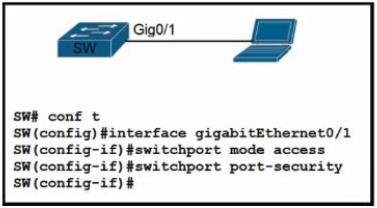 A network engineer started to configure port security on a new switch. These requirements
must be met:
•
MAC addresses must be learned dynamically.
•
Log messages must be generated without disabling the interface when unwanted traffic
is seen.
Which two commands must be configured to complete this task? (Choose two.)
A: SW(config-if)#switchport port-security violation restrict
B: SW(config-if)#switchport port-security mac-address 0010.7B84.45E6
C: SW(config-if)#switchport port-security maximum 2
D: SW(config-if)#switchport port-security violation shutdown
E: SW(config-if)#switchport port-security mac-address sticky
A network engineer started to configure port security on a new switch. These requirements
must be met:
•
MAC addresses must be learned dynamically.
•
Log messages must be generated without disabling the interface when unwanted traffic
is seen.
Which two commands must be configured to complete this task? (Choose two.)
A: SW(config-if)#switchport port-security violation restrict
B: SW(config-if)#switchport port-security mac-address 0010.7B84.45E6
C: SW(config-if)#switchport port-security maximum 2
D: SW(config-if)#switchport port-security violation shutdown
E: SW(config-if)#switchport port-security mac-address stickyShow Answer
B. SW(config-if)#switchport port-security mac-address 0010.7B84.45E6: This command
statically configures a MAC address, contradicting the requirement for dynamic learning.
D. SW(config-if)#switchport port-security violation shutdown: This is the default violation
mode and disables the interface, which is contrary to the requirement.
E. SW(config-if)#switchport port-security mac-address sticky: While sticky learning involves
dynamic learning, it's a specific type that also adds MACs to the running config. The primary
need for "MAC addresses" (plural) to be learned dynamically is addressed by setting the
maximum if the default of 1 is insufficient. Basic dynamic learning (non-sticky) also fulfills
the "learned dynamically" criteria. Option C is more fundamental if multiple MACs are
implied.
Cisco IOS Interface and Hardware Component Command Reference - switchport port-
security command:
"By default, port security is disabled on an interface... When port security is enabled, the
default maximum number of secure MAC addresses is 1. The default violation mode is
shutdown."
URL: (A general search for "Cisco IOS switchport port-security command reference" on
Cisco's official documentation site would lead to relevant documents for specific switch
models/IOS versions. For example, for Catalyst 9300 Series:)
/561
Cisco Catalyst 9300 Series Switches Command Reference, IOS XE Bengaluru 17.6.x -
Interface and Hardware Component Commands: switchport port-security
switchport port-security maximum value: "To set the maximum number of secure MAC
addresses on the interface... The default is 1." (
/561
Question 48
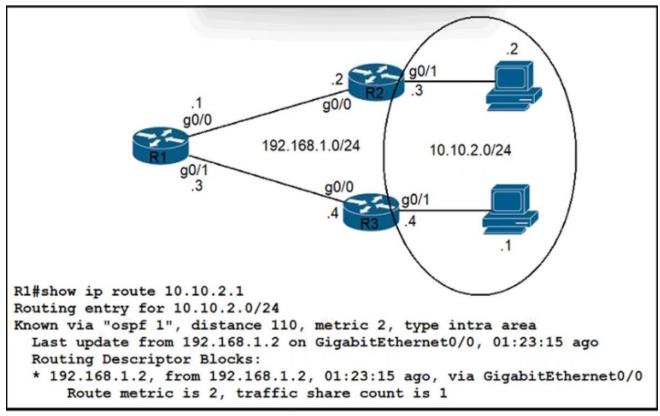 Traffic from R1 to the 10.10.2.0/24 subnet uses 192.168.1.2 as its next hop. A network
engineer wants to update the R1 configuration so that traffic with destination 10.10 2.1
passes through router R3, and all other traffic to the 10.10.2.0/24 subnet passes through
R2. Which command must be used?
A: Ip route 10.10.2.1 255.255.255.255 192.168.1.4 115
B: Ip route 10.10.2.0 255.255.255.0 192.168.1.4 100
C: Ip route 10.10.2.0 255.255.255.0 192.168.1.4 115
D: Ip route 10.10.2.1 255.255.255.255 192.168.1.4 100
Traffic from R1 to the 10.10.2.0/24 subnet uses 192.168.1.2 as its next hop. A network
engineer wants to update the R1 configuration so that traffic with destination 10.10 2.1
passes through router R3, and all other traffic to the 10.10.2.0/24 subnet passes through
R2. Which command must be used?
A: Ip route 10.10.2.1 255.255.255.255 192.168.1.4 115
B: Ip route 10.10.2.0 255.255.255.0 192.168.1.4 100
C: Ip route 10.10.2.0 255.255.255.0 192.168.1.4 115
D: Ip route 10.10.2.1 255.255.255.255 192.168.1.4 100Show Answer
A: Correct prefix/mask but AD 115 is worse than OSPF (110); traffic could revert to an
OSPF path if one exists.
B: /24 route would divert all 10.10.2.0/24 trafficincluding 10.10.2.1through R3, violating
requirement.
C: Same issue as B; AD change does not fix overly broad prefix.
1. Cisco IOS XE Command Reference: ip route syntax, host route with /32 mask, optional
distance parameter. https://www.cisco.com/c/en/us/td/docs/iosxml/ios/iproutestatic/configuration/xe-17/irs-xe-17-book/irs-overview.html (Section: Static
Route Syntax)
2. Cisco TAC How Cisco Routers Choose the Best Route longest-prefix match first, then
administrative distance. https://www.cisco.com/c/en/us/support/docs/ip/routing-informationprotocol-rip/13718-56.html (Section: Route Selection Process)
/561
Question 49
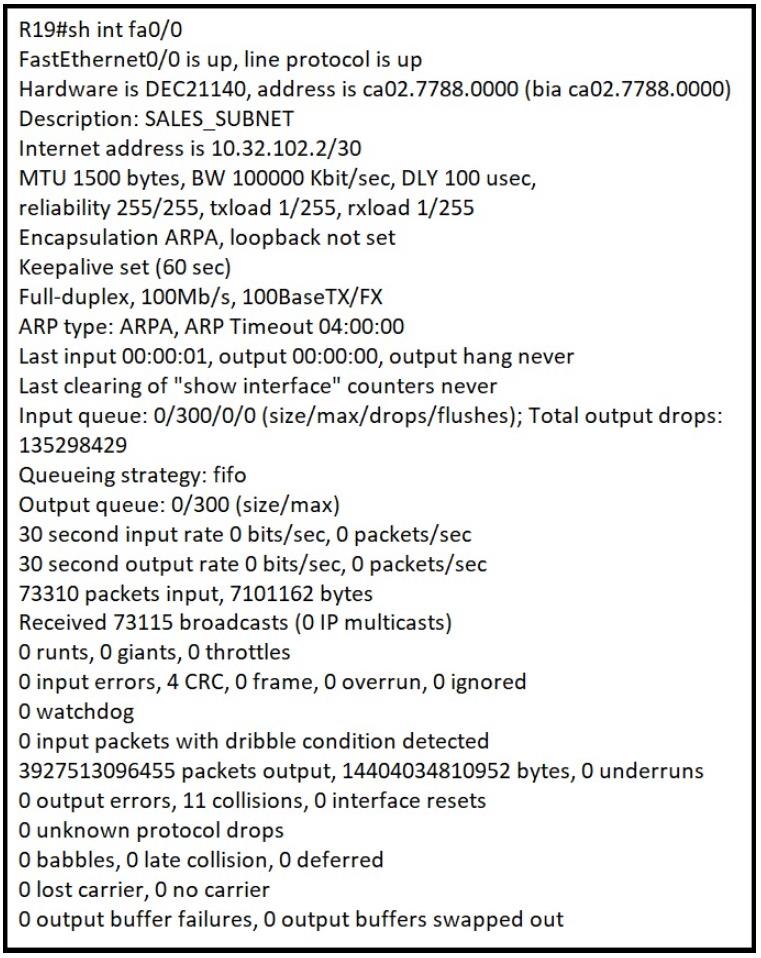 /561
What is the cause of poor performance on router R19?
A: excessive collisions
B: speed and duplex mismatch
C: port oversubscription
D: excessive CRC errors
/561
What is the cause of poor performance on router R19?
A: excessive collisions
B: speed and duplex mismatch
C: port oversubscription
D: excessive CRC errorsShow Answer
A. Excessive collisions are the symptom seen in the counters, not the underlying
configuration fault that produces them.
C. Port oversubscription occurs on a switch backplane, not on a single router interface; it
does not create late collisions.
D. CRC error counters would be high if bad frames were received; the exhibit shows
collisions, not CRC errors.
1. Cisco Systems, Troubleshooting Ethernet Duplex and Speed Mismatches, Section
˜SymptomsLate Collisions™ , https://www.cisco.com/c/en/us/support/docs/switches/catalyst6500-series-switches/118240-technote-duplex-00.html
2. IEEE Std 802.3-2018, Clause 4.4.2, Late collision generation due to duplex mismatch,
pp. 53-54.
3. Cisco Press, CCNA 200-301 Official Cert Guide, Vol.1, ch.10 Interface Troubleshooting,
pp. 254-255 (duplex mismatch and collision counters).
/561
Question 50
Show Answer
A: Kerberos: Primarily a network authentication protocol for client-server applications; while
it can authenticate administrators, it's less directly involved in the authorization aspects of
device configuration compared to TACACS+ or RADIUS.
B: 802.1Q: An IEEE standard for VLAN tagging in Ethernet networks, unrelated to
administrator authentication or configuration of access points.
C: 802.1X: An IEEE standard for port-based network access control, used to authenticate
users or devices connecting to the network via an access point, not for authenticating
administrators to the access point for management.
1. TACACS+ & RADIUS for Device Administration:
Cisco. (n.d.). TACACS+ and RADIUS Comparison. Cisco Technology White Paper.
"TACACS+ ... is commonly used for device administration... TACACS+ provides router
/561
command authorization..." and "RADIUS combines authentication and authorization...
RADIUS is often the choice for remote access." (While the quote mentions remote access,
RADIUS is also used for device admin AAA).
Note: Specific Cisco whitepaper URLs can be volatile. The concept is widely documented in
Cisco's security and device administration guides. A general reference point: Cisco,
Securing User Services Configuration Guide, Cisco IOS XE Gibraltar 16.12.x - RADIUS.
Available from Cisco's official documentation site. (e.g.,
https://www.cisco.com/c/en/us/td/docs/ios-xml/ios/secusrrad/configuration/16-12/sec-usrrad-16-12-book/sec-usr-rad-overview.html - "RADIUS is a distributed client/server system
that secures networks against unauthorized access.")
Cisco. (n.d.). RADIUS Authentication, Authorization, and Accounting for Managing Cisco
Devices. Cisco Configuration Guide. (Illustrates RADIUS for device management).
Example from a Cisco guide: "You can use RADIUS for authentication, authorization, and
accounting (AAA) of users who manage Cisco devices." (Found in various Cisco IOS
configuration guides for AAA).
2. Kerberos:
Neuman, C., Yu, T., Hartman, S., & Raeburn, K. (2005). The Kerberos Network
Authentication Service (V5). RFC 4120. IETF. (Defines Kerberos primarily as an
authentication service).
URL: https://datatracker.ietf.org/doc/html/rfc4120 (Section 1: "Kerberos is a trusted third-
party authentication service.")
3. 802.1Q:
IEEE Std 802.1Q-2018. (2018). IEEE Standard for Local and metropolitan area
networksBridges and Bridged Networks. IEEE Standards Association. (Defines VLANs).
URL: https://standards.ieee.org/standard/8021Q-2018.html (Abstract and scope describe
VLAN tagging and bridge operations).
4. 802.1X:
IEEE Std 802.1X-2020. (2020). IEEE Standard for Local and metropolitan area
networksPort-Based Network Access Control. IEEE Standards Association. (Defines port-
based NAC for authenticating clients).
URL: https://standards.ieee.org/standard/8021X-2020.html (Abstract and scope describe
authenticating and authorizing devices to attach to a LAN or WLAN).
/561
Question 51
Show Answer
A: Both have a 62.5 micron core diameter. This core diameter is characteristic of older
multimode fibers like OM1 and some OM2, not OM3 or OM4.
C: Both have a 100 micron core diameter. This is not a standard core diameter for common
telecommunication-grade multimode fibers like OM3 or OM4.
D: Both have a 9 micron core diameter. This core diameter is characteristic of single-mode
fibers (e.g., OS1, OS2), not multimode fibers like OM3 or OM4.
1. Corning Incorporated. (2021). Corning® ClearCurve® OM3 Multimode Fiber Product
Information Sheet PI1370. Page 1. Retrieved from Corning's official website. (Specifies
"Core Diameter: 50 ± 2.5 µm").
2. Corning Incorporated. (2021). Corning® ClearCurve® OM4 Multimode Fiber Product
Information Sheet PI1381. Page 1. Retrieved from Corning's official website. (Specifies
"Core Diameter: 50 ± 2.5 µm").
3. IEC 60793-2-10:2019. Optical fibres - Part 2-10: Product specifications - Sectional
specification for category A1 multimode fibres. International Electrotechnical Commission.
(This standard defines the specifications for multimode fiber categories, including A1a.2 for
OM3 and A1a.3 for OM4, both having a 50 µm core diameter). Abstract available at
https://webstore.iec.ch/publication/60005.
/561
4. Agrawal,
G. P. (2010). Fiber-Optic Communication Systems (4th ed.). Wiley. Chapter 2,
Section 2.2 "Optical Fibers: Structures, Waveguiding, and Fabrication" typically discusses
fiber types and their core/cladding dimensions. (Standard academic textbook confirming
multimode fiber dimensions).
/561
Question 52
Show Answer
B: This statement is incorrect; UDP does not reliably guarantee delivery, while TCP is
designed for reliable delivery and retransmits lost packets.
C: UDP does not inherently use flow control mechanisms; TCP employs both flow control
and congestion control.
D: UDP does not use sequencing to ensure packets arrive in order; TCP uses sequence
numbers for ordered delivery.
1. Kurose,
J. F., & Ross,
K. W. (2021). Computer Networking: A Top-Down Approach (8th
ed.). Pearson.
/561
Regarding TCP acknowledgments and reliability: "TCP provides reliable data transfer. [...]
The sending and receiving TCP entities in the end systems exchange control information
about the segments they send and receive. This control information [which includes
acknowledgments] is used by the sender and receiver to implement a reliable data transfer
service." (Chapter 3.5, pp. 243-244). "A TCP sender retransmits a segment if it doesn™ t
receive an acknowledgment for the segment before a timeout event." (Chapter 3.5.4,
paraphrased, discussing reliable data transfer principles applied in TCP).
Regarding UDP's lack of acknowledgments: "UDP is an unreliable, connectionless protocol.
[...] UDP provides no acknowledgments, so the sender does not know whether a sent
segment has been received at the destination." (Chapter 3.3, pp. 229-231, paraphrased).
2. Postel, J. (1981). RFC 793: Transmission Control Protocol. Internet Engineering Task
Force (IETF).
Section 3.1 (Functional Specification - Basic Data Transfer): "TCP is able to transfer a
continuous stream of octets in each direction by packaging some number of octets into
segments for transmission through the internet system. In general, TCPs decide when to
block and forward data at their own convenience. [...] To achieve reliability, TCPs use
sequence numbers to track octets and acknowledgments to verify receipt."
3. Postel, J. (1980). RFC 768: User Datagram Protocol. Internet Engineering Task Force
(IETF).
Introduction: "This User Datagram Protocol (UDP) is defined to make available a datagram
mode of packet-switched computer communication in the environment of an interconnected
set of computer networks. This protocol assumes that the Internet Protocol (IP) is used as
the underlying protocol. This protocol provides a procedure for application programs to send
messages to other programs with a minimum of protocol mechanism. The protocol is
transaction oriented, and delivery and duplicate protection are not guaranteed." (This
highlights the lack of reliability mechanisms like acknowledgments).
/561
Question 53
Show Answer
A: Omits the vlan keyword, so the MAC would be applied to the access VLAN, not the voice
VLAN.
C: Uses the sticky keyword, which tells the switch to learn the MAC dynamically rather than
configuring it manually.
D: Uses vlan voice; while syntactically valid, it is less precise than explicitly identifying
VLAN 4 as required.
1. Cisco Catalyst 2960/3560/3750 Switch Command Reference, switchport port-security
mac-address Syntax shows vlan {access | voice | vlan-id}.
2. Cisco IOS Security Configuration Guide, Port Security chapter explains manual vs sticky
MAC address configuration. https://www.cisco.com/c/en/us/support/docs/security/iossecurity/17048-5.html
/561
Question 54
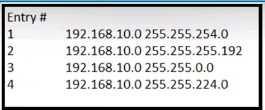 Which entry is the longest prefix match for host IP address 192.168.10.5?
A: 1
B: 2
C: 3
D: 4
Which entry is the longest prefix match for host IP address 192.168.10.5?
A: 1
B: 2
C: 3
D: 4Show Answer
A (Entry 1): While this route (192.168.10.0/23) contains the destination IP, its prefix is
shorter than those of Entry 2 and Entry 4. The longest match rule requires selecting the
most specific route.
B (Entry 2): This route (192.168.10.0/26) is a valid match but its prefix is shorter than Entry
4's prefix (/27). The router will prefer the more specific /27 route.
C (Entry 3): This entry (192.168.10.0 with mask 255.255.0.0) is not a valid match. Applying
the /16 mask to the destination IP 192.168.10.5 yields the network 192.168.0.0, which is
different from the network 192.168.10.0 specified in the entry.
IETF RFC 1812, "Requirements for IP Version 4 Routers":
Reference: Section 5.2.4.3, "Forwarding Algorithm".
Content: "When forwarding a datagram, a router MUST use the route in its routing table that
has the longest match with the datagram's destination IP address."
URL: https://datatracker.ietf.org/doc/html/rfc1812#section-5.2.4.3
Cisco Systems, "IP Routing: Protocol-Independent Configuration Guide, Cisco IOS XE
Gibraltar 16.11.x":
Reference: Chapter: "Configuring a Gateway of Last Resort Using IP Commands", Section:
"How a Router Selects a Route".
Content: "The router examines all routes in the table that match the destination address,
and if it finds more than one match, it uses the one with the longest prefix."
/561
MIT OpenCourseWare, "6.02 Introduction to EECS II: Digital Communication Systems, Fall
2012":
Reference: Lecture 15 Notes, "Routing: How packets get from here to there".
Content: "What if an address matches more than one prefix? We use the longest prefix
match rule: the entry with the longest prefix that matches the destination address is the one
used."
URL: https://ocw.mit.edu/courses/6-02-introduction-to-eecs-ii-digital-communicationsystems-fall-2012/pages/lecture-notes/ (See Lecture 15 PDF)
/561
Question 55
Show Answer
A: Software upgrades and file restoration are management plane tasks, not the primary
function of an SDN northbound API, which focuses on application-to-controller
communication.
B: While the SDN controller handles provisioning, the northbound API's function is to enable
applications to request these, not to "rely on" them as its defining characteristic.
C: Distributed processing for configuration describes a potential architectural feature of the
controller or system, not the specific function of the northbound API, which is an interface.
1. Kreutz, D., Ramos,
F. M. V., VerÃssimo,
P. E., Rothenberg,
C. E., Azodolmolky, S., &
Uhlig, S. (2015). Software-Defined Networking: A Comprehensive Survey. Proceedings of
the IEEE, 103(1), 14-76. (Specifically, Section III-A, "The Northbound Interface," p. 23: "The
northbound interface is used by applications to make their needs known to the controller.")
Direct URL (via IEEE Xplore): https://ieeexplore.ieee.org/document/6994383
2. Nunes,
B. A. A., Mendonca, M., Nguyen,
X. N., Obraczka, K., & Turletti,
T. (2014). A
Survey of Software-Defined Networking: Past, Present, and Future of Programmable
Networks. ACM Computing Surveys, 46(4), Article 50. (Specifically, Section 2.1, "SDN
/561
Architecture," p. 50:4: "The Northbound Interface (NBI) defines the communication channel
between SDN applications and the SDN controller.")
Direct URL (via ACM Digital Library): https://dl.acm.org/doi/10.1145/2650497
3. Open Networking Foundation (ONF). (n.d.). SDN Architecture Overview. (While ONF is
an industry consortium, its foundational documents on SDN architecture are widely
referenced in academic literature and define these concepts). The ONF architecture clearly
depicts the northbound API as the interface between the Network Applications and the SDN
Controller.
A representative document often cited is the "SDN Architecture Issue 1". While direct links
to specific versions can change, university courseware often refers to these foundational
concepts. For example, Stanford's CS244 course materials on SDN discuss this
architecture. (e.g., https://cs244.stanford.edu/ - specific lecture slides would detail this).
/561
Question 56
Show Answer
A: northbound interface: Connects the SDN controller to higher-level applications and
services, not directly to programs on networking devices.
B: software virtual interface: An SVI is a logical Layer 3 interface on a switch used for inter-
VLAN routing, not for controller-device communication.
D: tunnel Interface: A logical interface for encapsulating traffic, not the primary interface for
controller-to-device program communication.
Stallings, W. (2016). Foundations of Modern Networking: SDN, NFV, QoE, IoT, and Cloud.
Pearson Education, Inc. (Chapter 5, Section 5.2 "SDN Architecture," describes southbound
interfaces as connecting the controller to network devices).
Nunes,
B. A. A., Mendonca, M., Nguyen,
X. N., Obraczka, K., & Turletti,
T. (2014). A Survey
of Software-Defined Networking: Past, Present, and Future of Programmable Networks.
IEEE Communications Surveys & Tutorials, 16(3), 1617-1634. (Section III.A "SDN
Architecture" discusses southbound APIs for controller-switch communication). (Available
via IEEE Xplore)
Kreutz, D., Ramos,
F. M. V., VerÃssimo,
P. E., Rothenberg,
C. E., Azodolmolky, S., & Uhlig,
S. (2015). Software-Defined Networking: A Comprehensive Survey. Proceedings of the
/561
IEEE, 103(1), 14-76. (Section III "THE SDN LANDSCAPE," subsection "Southbound APIs"
describes these as interfaces between the controller and network elements). (Available via
IEEE Xplore)
/561
Question 57
 Which action by the router when a packet is sourced from 10.10.10.2 and destined
10.10.10.16?
A: It queues the packets waiting for the route to be learned.
B: It floods packets to all learned next hops.
C: It discards the packets.
D: It uses a route that is similar to the destination address.
Which action by the router when a packet is sourced from 10.10.10.2 and destined
10.10.10.16?
A: It queues the packets waiting for the route to be learned.
B: It floods packets to all learned next hops.
C: It discards the packets.
D: It uses a route that is similar to the destination address.Show Answer
A. Routers do not queue and wait for routes; they forward or drop based on the current
table.
B. Flooding applies to layer-2 switches (or some multicast processes), not to unicast IP
routing.
/561
D. IOS never selects a similar but non-matching prefix; it must match exactly the longest
prefix that contains the destination.
1. Cisco Systems, IP Routing Fundamentals CEF and Forwarding, IOS XE Release 17,
section Longest-Match Routing Decision.
https://www.cisco.com/c/en/us/support/docs/ip/routing-information-protocol-rip/13788-3.html
2. Doyle,
J. & Carroll,
J. Routing TCP/IP, Vol. 1 (2nd ed.), Addison-Wesley/Cisco Press,
2005, pp. 43-46 (Longest prefix match and drop behaviour).
/561
Question 58
Show Answer
B: Switches learn source MAC addresses dynamically, not destination MACs, and don't
create static entries or shut down ports for unknown unicast frames.
C: The CAM table is updated with the source MAC address and the ingress port of received
frames, not the destination MAC address.
D: Switches do not modify the checksum to indicate an invalid frame for unknown
destinations; they forward the original frame or drop it if an error is detected.
Cisco. (n.d.). How a Switch Works. Cisco Networking Academy. (Content often derived from
official Cisco documentation and principles).
Specifically, the concept of "flooding" for unknown unicast frames: "If the destination MAC
address is not in the table, the switch forwards the frame out all ports except the port on
which it was received. This is called flooding." This behavior is VLAN-specific. (General
principle found in CCNA curriculum materials like CCNA Switching, Routing, and Wireless
Essentials Companion Guide, Chapter 2: Switching Concepts).
IEEE Std 802.1Q-2018. (2018). IEEE Standard for Local and Metropolitan Area
NetworksBridges and Bridged Networks. IEEE Xplore.
/561
Section 8.8.2 "Forwarding Process": Describes that if the filtering database (MAC address
table) lookup for the destination MAC address fails, the frame is flooded to all other bridge
ports that are in the forwarding state for that VLAN. (e.g., "If no entry is found for a unicast
address, the frame shall be flooded...")
Tanenbaum,
A. S., & Wetherall,
D. J. (2011). Computer Networks (5th ed.). Pearson
Education.
Chapter 4, Section 4.6.2 "Learning Bridges/Switches": "If the destination address is not in
the hash table, the bridge simply broadcasts the incoming frame on all the other lines."
(Switches are multi-port bridges).
/561
Question 59
Show Answer
A: authorization: Authorization determines what an authenticated entity is permitted to do; it
does not prevent an attacker from intercepting the communication itself.
C: anti-replay: Anti-replay mechanisms prevent attackers from resending captured, valid
messages but do not directly prevent the interception and impersonation inherent in MitM
attacks.
D: accounting: Accounting tracks actions performed by users for auditing and accountability,
which is a detective control, not a primary preventative measure against MitM attacks.
1. Kurose,
J. F., & Ross,
K. W. (2021). Computer Networking: A Top-Down Approach (8th
ed.). Pearson. In Chapter 8.2, "Principles of Cryptography," and Chapter 8.3, "Message
Integrity and Digital Signatures," the concepts leading to secure communication are
discussed. Chapter 8.6.3, "SSL Handshake," explicitly details how server authentication
(and optionally client authentication) using certificates helps prevent MitM attacks. "The
server sends its certificate... The client then verifies the certificate... This part of the
handshake protocol is critically important, as it is where the client authenticates the server."
(Paraphrased from typical SSL/TLS handshake descriptions).
/561
2. Stallings, W. (2017). Cryptography and Network Security: Principles and Practice (7th
ed.). Pearson. Chapter 17, "Transport-Level Security," discusses SSL/TLS, where
authentication of the server (and optionally the client) is a key feature to prevent MitM
attacks. "The SSL handshake protocol allows the server and client to authenticate each
other..."
3. National Institute of Standards and Technology (NIST). (2013). NIST Special Publication
800-52 Revision 1: Guidelines for the Selection, Configuration, and Use of Transport Layer
Security (TLS) Implementations. Section 3.3.1, "Server Authentication." "TLS server
authentication is essential for secure communication. It allows clients to verify the identity of
the server, which helps prevent man-in-the-middle attacks." (Direct URL:
https://nvlpubs.nist.gov/nistpubs/SpecialPublications/NIST.SP.800-52r1.pdf, Page 12).
/561
Question 60
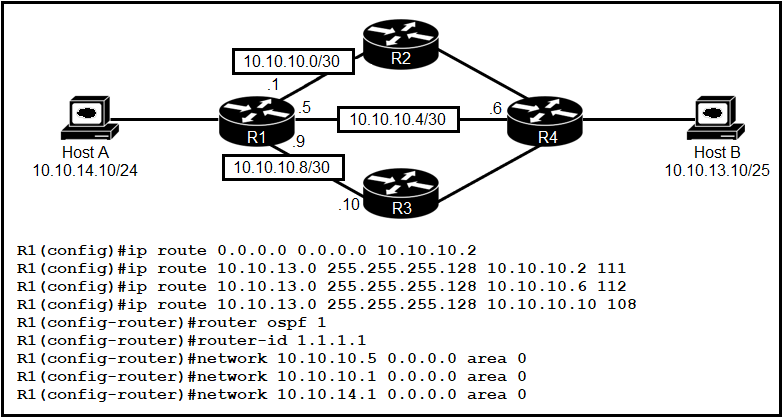 R1 has just received a packet from host A that is destined to host B. Which route in the
routing table is used by R1 to reach host B?
A: 10.10.13.0/25 [108/0] via 10.10.10.10
B: 10.10.13.0/25 [110/2] via 10.10.10.2
C: 10.10.13.0/25 [110/2] via 10.10.10.6
D: 10.10.13.0/25 [1/0] via 10.10.10.2
R1 has just received a packet from host A that is destined to host B. Which route in the
routing table is used by R1 to reach host B?
A: 10.10.13.0/25 [108/0] via 10.10.10.10
B: 10.10.13.0/25 [110/2] via 10.10.10.2
C: 10.10.13.0/25 [110/2] via 10.10.10.6
D: 10.10.13.0/25 [1/0] via 10.10.10.2Show Answer
A: This route (AD 108, next-hop 10.10.10.10) is not present in the provided routing table
exhibit for the destination prefix 10.10.13.0/25.
B: This OSPF route (10.10.13.0/25 [110/2] via 10.10.10.2) has an AD of 110, which is higher
than the static route's AD (1), making it less preferred.
C: This specific OSPF route (10.10.13.0/25 [110/2] via 10.10.10.6) is not in the exhibit. The
OSPF route shown for this prefix is via 10.10.10.2.
Cisco Systems, "IP Routing: Protocol-Independent Configuration Guide, Cisco IOS XE
Cupertino 17.7.x" - Chapter: "Configuring Basic IP Addressing and Routing", Section:
"Information About Implementing Basic IP Addressing and Routing", Subsection: "Route
Selection". This document states that administrative distance is the first criterion for route
preference when multiple routes to the same prefix exist. (Direct URL:
Cisco Systems, "What Is Administrative Distance?" - This document explains that
"Administrative distance is the feature that routers use in order to select the best path when
there are two or more different routes to the same destination from two different routing
protocols." It also lists default AD values (Static=1, EIGRP (Internal)=90, OSPF=110,
RIP=120). (Direct URL: https://www.cisco.com/c/en/us/support/docs/ip/enhanced-interiorgateway-routing-protocol-eigrp/8651-21.html)
/561

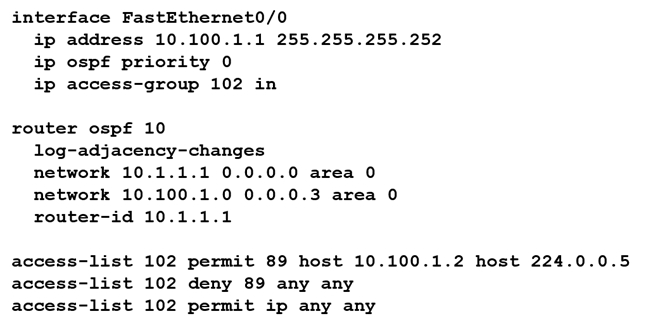
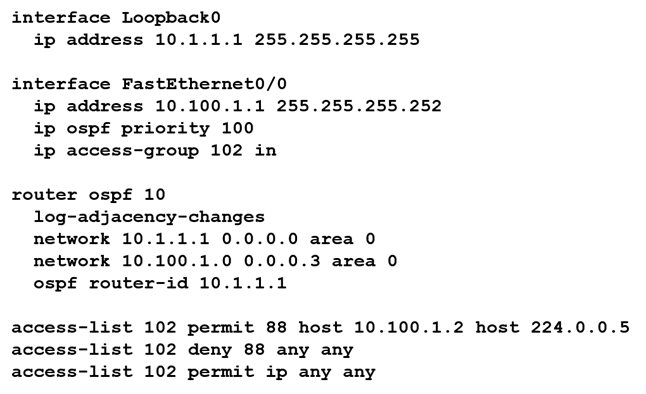
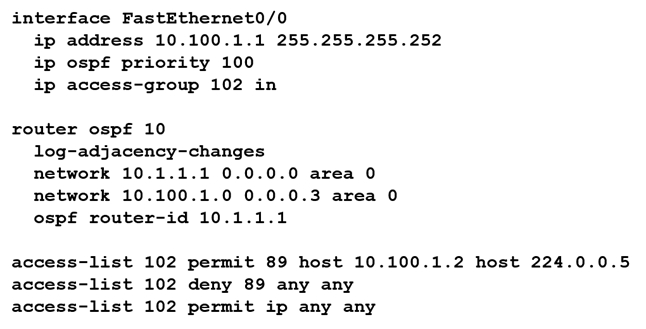
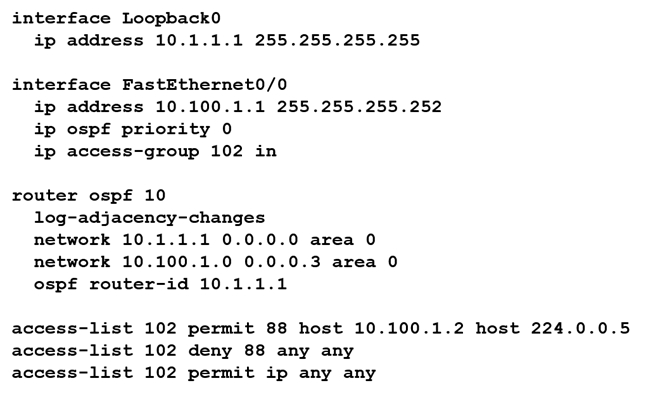 A: Option A
B: Option B
C: Option C
D: Option D
A: Option A
B: Option B
C: Option C
D: Option D
